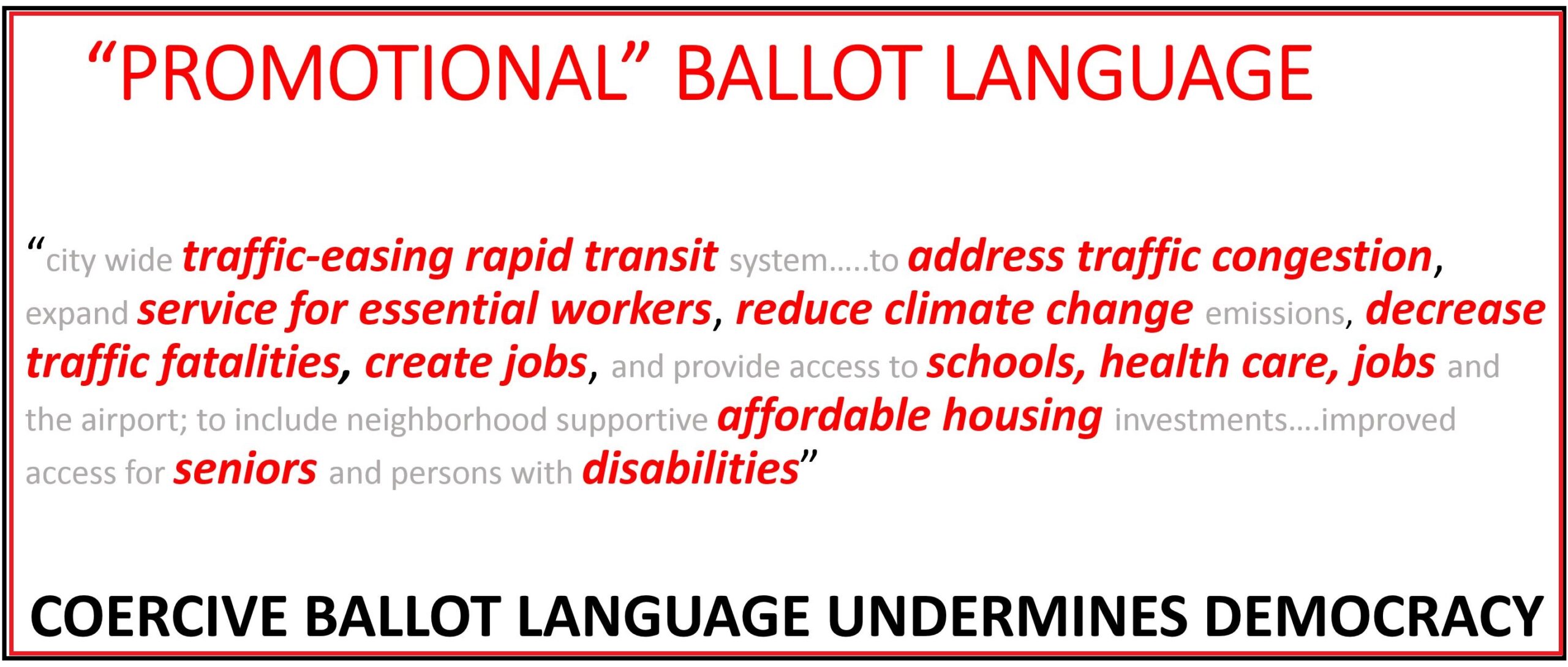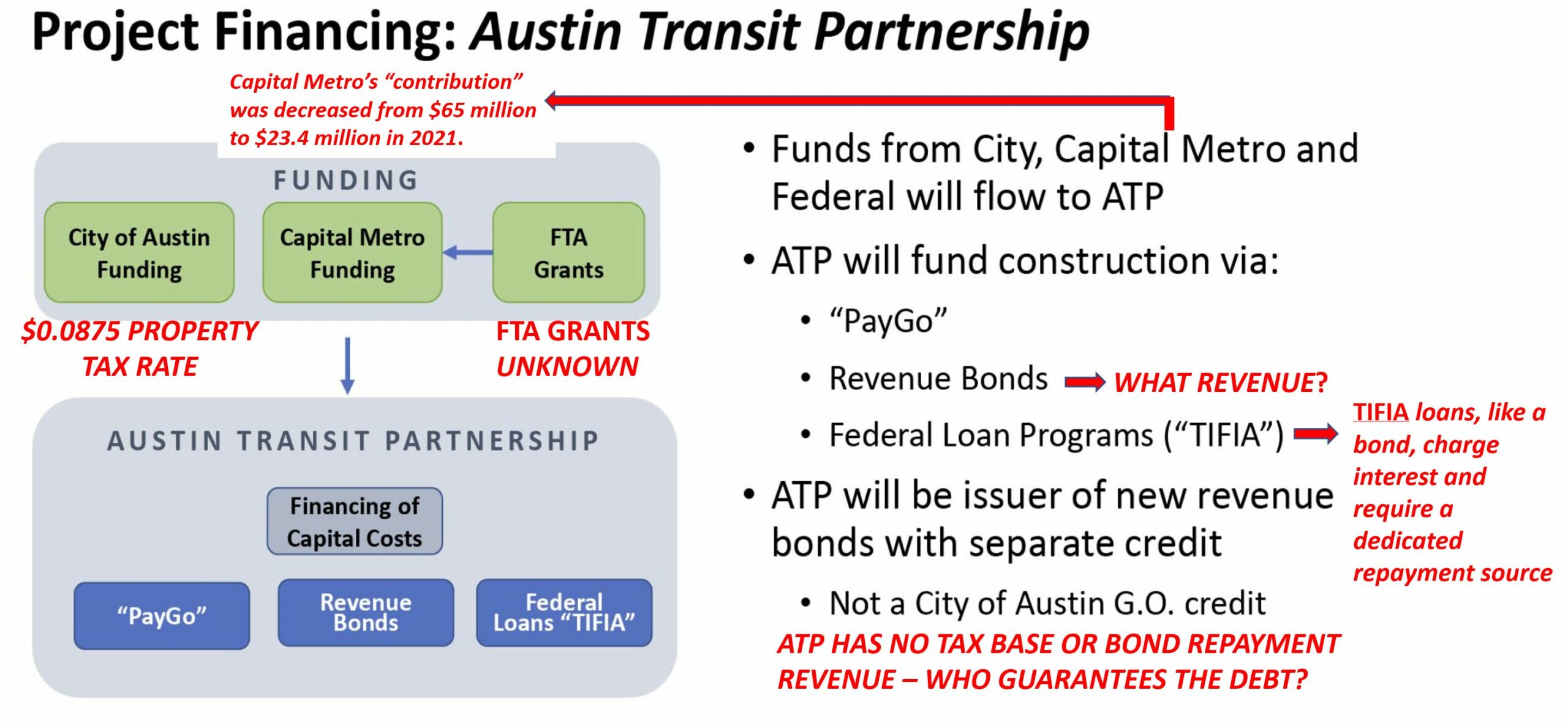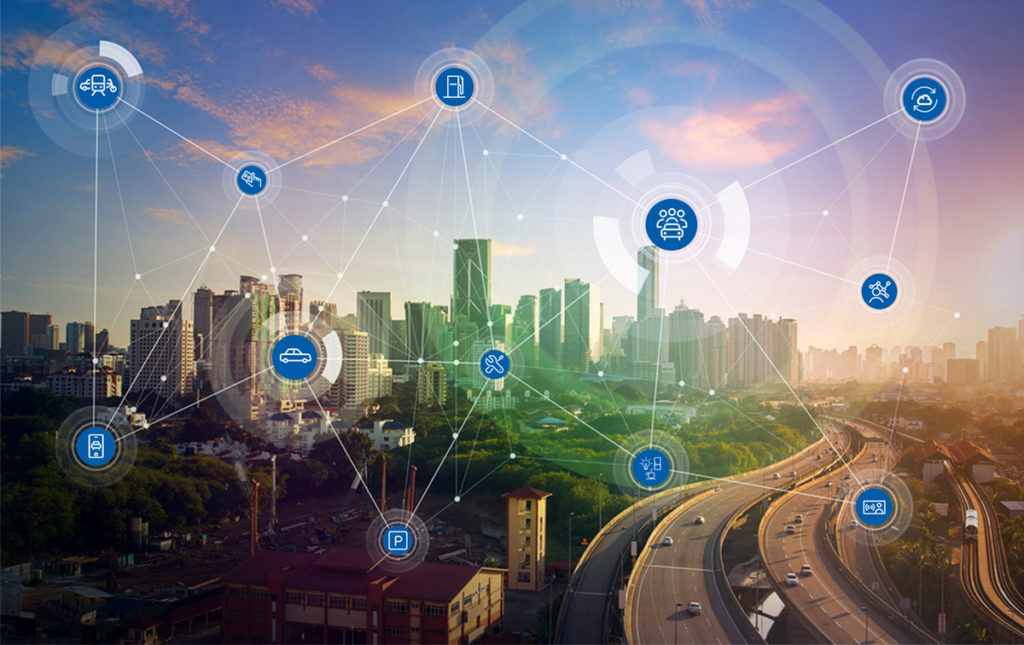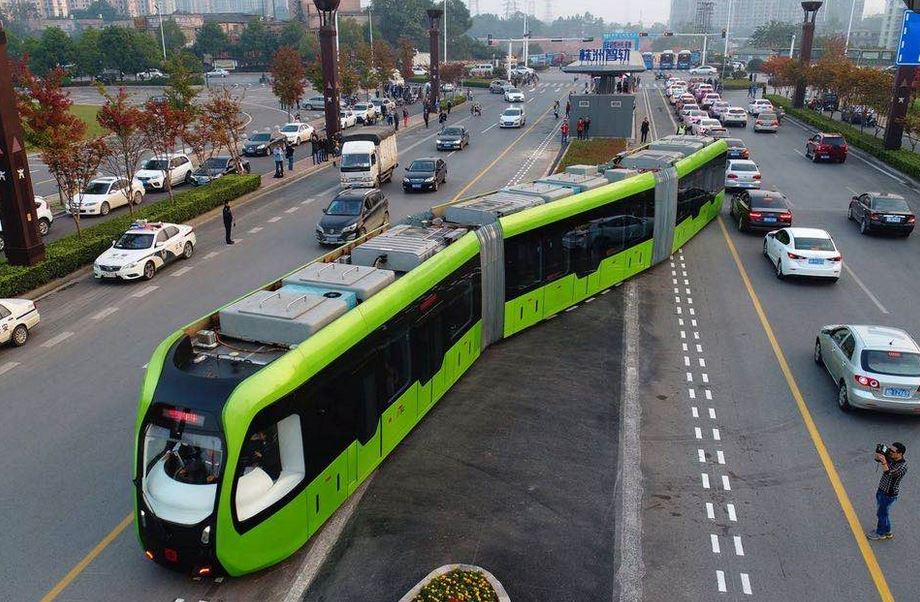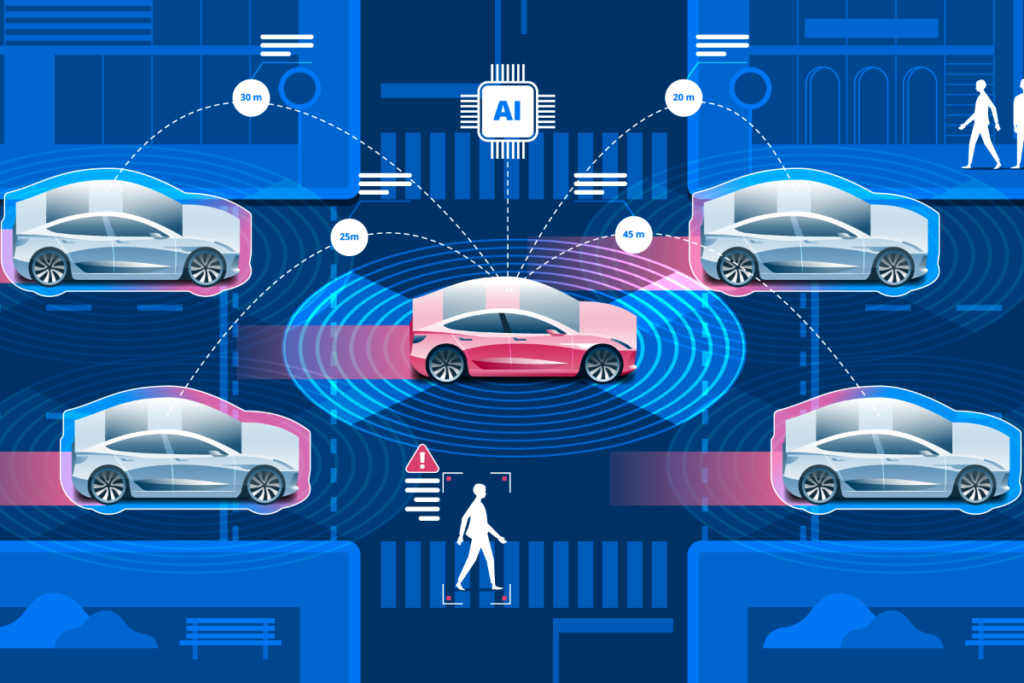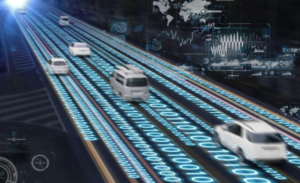
TABLE OF CONTENTS
FORWARD
A NEW MOBILITY
PUBLIC TRANSIT IN THE AGE OF PANDEMIC
DRIVER EDUCATION
V2X (Connected & Coordinated Vehicles)
5-6g COMMUNICATION
MOBILITY AS A SERVICE (MaaS)
SHARED MOBILITY
MOBILITY HUBS/PASSENGER ACCESS ZONES
MICRO MOBILITY (Scooters, Bikes, eBikes)
TRACKLESS ELECTRIC TRAMS
MICRO TRANSIT
AUTONOMOUS VEHICLES
E-COMMERCE – AUTOMATION
ELECTRIFICATION – ALTERNATIVE TRANSPORTATION ENERGY – DIGITAL WORKPLACE
RENEWABLE ENERGY
ROADWAY IMPROVEMENT
ROADWAY MANAGEMENT
TRAVEL DEMAND MANAGEMENT (TDM)
CITY OF AUSTIN
CAPITAL METRO
MARKET DRIVEN SOLUTIONS & HYPERLOOP
FUNDING ProCON
FORWARD
LATEST ANALYSIS ON ProCON:
- Austin’s mayor states: ProCON “bonds are backed by the dedicated property tax revenue already approved by voters in 2020.” That violates the Texas Constitution.
- The “record-historic” ProCON tax increase will bring in an average of ~$180m/yr, in the period ATP claims they need to issue bonds.
- Half this money is committed in ATP’s budget: “The FY23 expenditure budget is $90.6 million, which includes all operating costs, including staff salaries, rent and utilities, and administrative contracts, as well as reimbursements totaling $3.5 million for the City of Austin’s Project Connect Office and $3.8 million for shared services with CapMetro, and the transfers to the reserve and Anti-Displacement Initiatives funds” That leaves $90m to “back bonds”.
- At current rates, $90m/yr only services $1.265b of bond debt – less if rates rise further.
- ProCON rail cost is now estimated at $5b. IF the FTA gave them 45%, the local “match” is $2.75b. At current rates, $90m can service $1.27b in bonds (less if rates rise further). That leaves ProCON $1.5b short. Where will that money come from?
- That’s just the rail, other promises made to voters in 2020 like electric buses, 12 new park/rides, a second commuter rail, 23 circulators, 8 new rapid transit lines and Red Line improvements add up to over 1.3b – Where will THAT money come from?
- ProCON Maintenance and Operating cost is estimated at ~$200m/year – Where will THAT money come from?
- Rating agencies like S&P, Zachs, Moodys, etc, will likely find the data, ATP’s cost escalation/guess errors and the “bait and switch” serious problems. ProCON is tainted and in controversy, conditions that don’t inspire great credit rating and investor confidence. A BIGGER PROBLEM: State law requires the property tax transfer from the City to ATP be re-approved and subject to termination every year. NO BOND INVESTOR OR INVESTMENT BANK WILL LOAN ATP MONEY FOR A 25-35 YEAR TERM UNDER THESE CONTINGENCIES. Investors value consistency, certainty and security on long term investment, this annual review is a deal killer. These same issues apply to Federal Transit Administration TIFIA funding.
- Less than 2% of Austin residents use public transit for their mobility, we rank #4 nationally for automobile ownership, public transit is less than 1% of regional trips, our population density of 3,300 people/sq. mile, doesn’t justify light rail and the impotence/inequity of all the proposed scaled back rail options, all bring the entire plan into question. These are also ALL key scoring metrics for FTA funding.
VOTERS IN 2020 WERE PROMISED AND APPROVED:
- A train to the airport
- A subway
- A massive, regional Capital Metro transit center
- An underground concert venue/bandstand
- A second commuter rail
- Tunnels to avoid traffic
- Traffic congestion and climate change relief
- Trains to far north Austin (Tech Ridge)
- Trains to far south Austin (Stassney)
- An underground mall and food court
- Massive downtown station with shops and transfer points
- 12 new park and rides
- 22 circulators
- Electric buses
- 9 new Rapid Transit lines
- Red Line expansion
What the ATP is proposing in 2023 includes little of that – it’s a classic, record-historic BAIT AND SWITCH. They say voters approved ProCON, but what they are offering is nothing like what was told to voters. If a business operated like that they would be found guilty of deceptive trade practices. The ATP and City think people are easily fooled and they can, again, promise their way to victory. “
______________________________________________________________________________________________________________________
This position paper’s intent is to inform the public of contemporary trends that are transforming mobility. We also present thoughtful counterpoint to the Project Connect (ProCON) narrative. We don’t profess to be transportation experts; we offer consolidated information sourced from the internet, published documents, public record, and industry professionals. It is our opinion that the cleverly concocted and promoted ProCON is a short-sighted, expensive mistake that takes Austin down an obsolete dead end. Mobility is integral to our lives, commerce, and emergency services; it’s too important to get wrong.
Digital technology has revolutionized communication, information, shopping, photography, entertainment and more. Some of our best and brightest engineering minds, fueled with tens of billions of dollars, are developing technology that will drastically improve mobility. While some of these technologies are still evolving, many are already at work. A”New Mobility will render light rail obsolete for moving urban travelers efficiently, conveniently and cost effectively to a diversity of destinations. This “New Mobility” will have far greater impact on traffic congestion, improve roadway safety and expand transportation choice in a multimodal environment.
The “New Mobility” ushers in an era of distributed, on-demand/door-to-door transportation and connected roadway coordination. Fixed-route/fixed-schedule systems like ProCON, are not competitive compared to the vastly superior convenience and time saving of the New Mobility. Let’s move forward, not backward!
”Door-to-door….efficient travel made possible with….Connected and Automated vehicles, will change the face of transportation and mobility in the 21st century and beyond” – City of Austin Smart Cities application
“Technology disruptors coming to market every week, will alter the urban mobility landscape.” – Texas Transportation Institute, 2019 Mobility Report
“The evolution of technology moves at a mind-blowing pace and that pace of change is coming to mobility in a major way.” – Kirk Watson
- NONE of the political “leaders” at the worksessions, ever dug into the glaring multi-billion-dollar funding gap and asked hard questions. Ignorance? Incompetence? Abdication of duty? All the above? They failed us!
Ballot language should be brief, to the point and never include language intended to coerce voters. The ProCON ballot language, loaded with unproven claims and “buzzwords” violated all those rules:
CAPITAL METRO USED PUBLIC MONEY TO FUND ITS PROPAGANDA DRIVE AND CONDITION LOCAL MEDIA
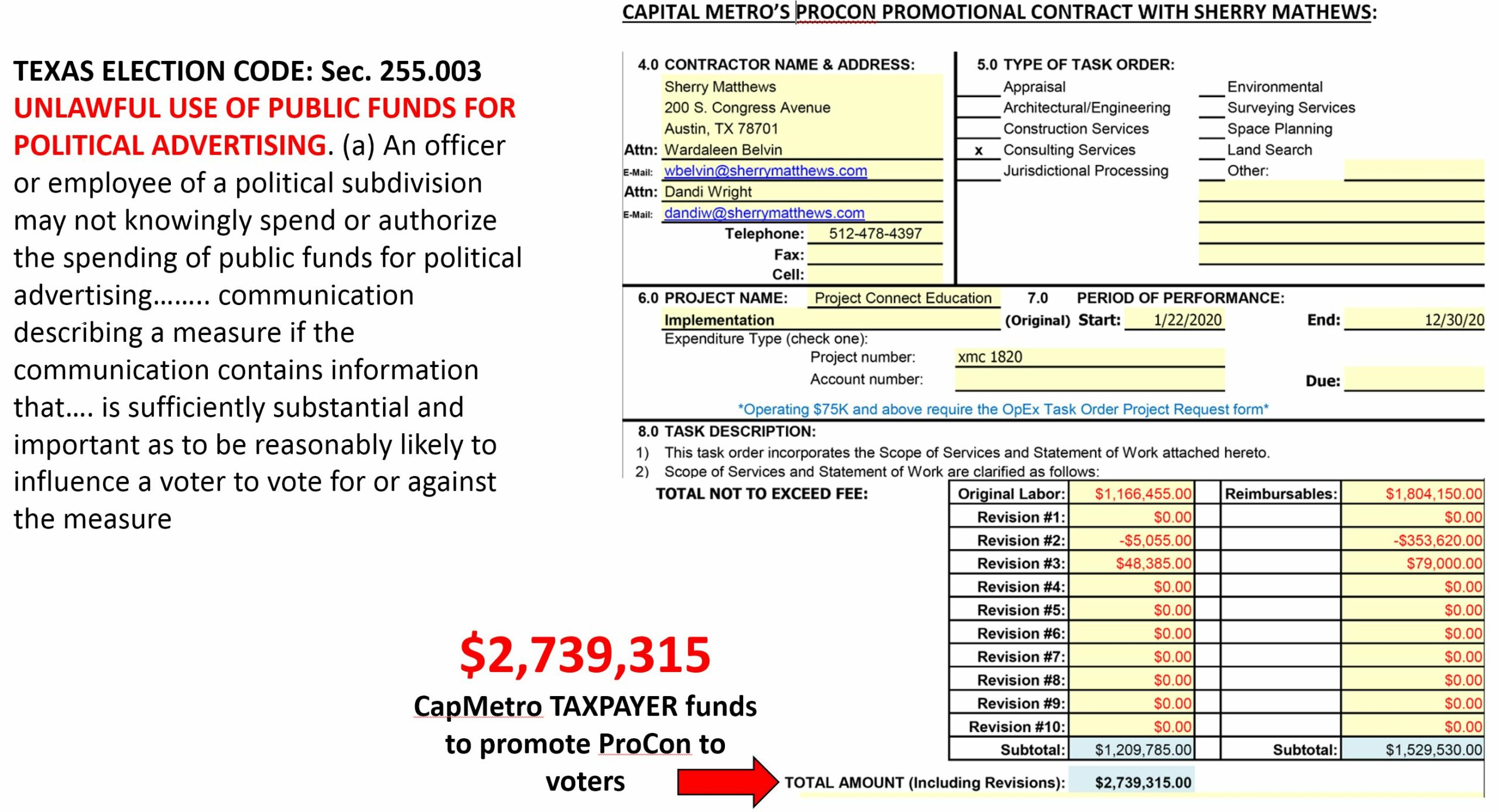
AS IF THAT WASN’T ENOUGH, CONSULTANTS ON CAPITAL METRO’S PAYROLL, ALONG WITH OTHER SPECIAL INTERESTS EXPECTING TO PROFIT FROM THE TAXES, POURED HUNDREDS OF THOUSANDS OF DOLLARS MORE INTO THE PAC TO GET THE GRAVY TRAIN ROLLING:

CAPITOL METRO AND THE CITY LURED VOTERS WITH FALSE IMAGES
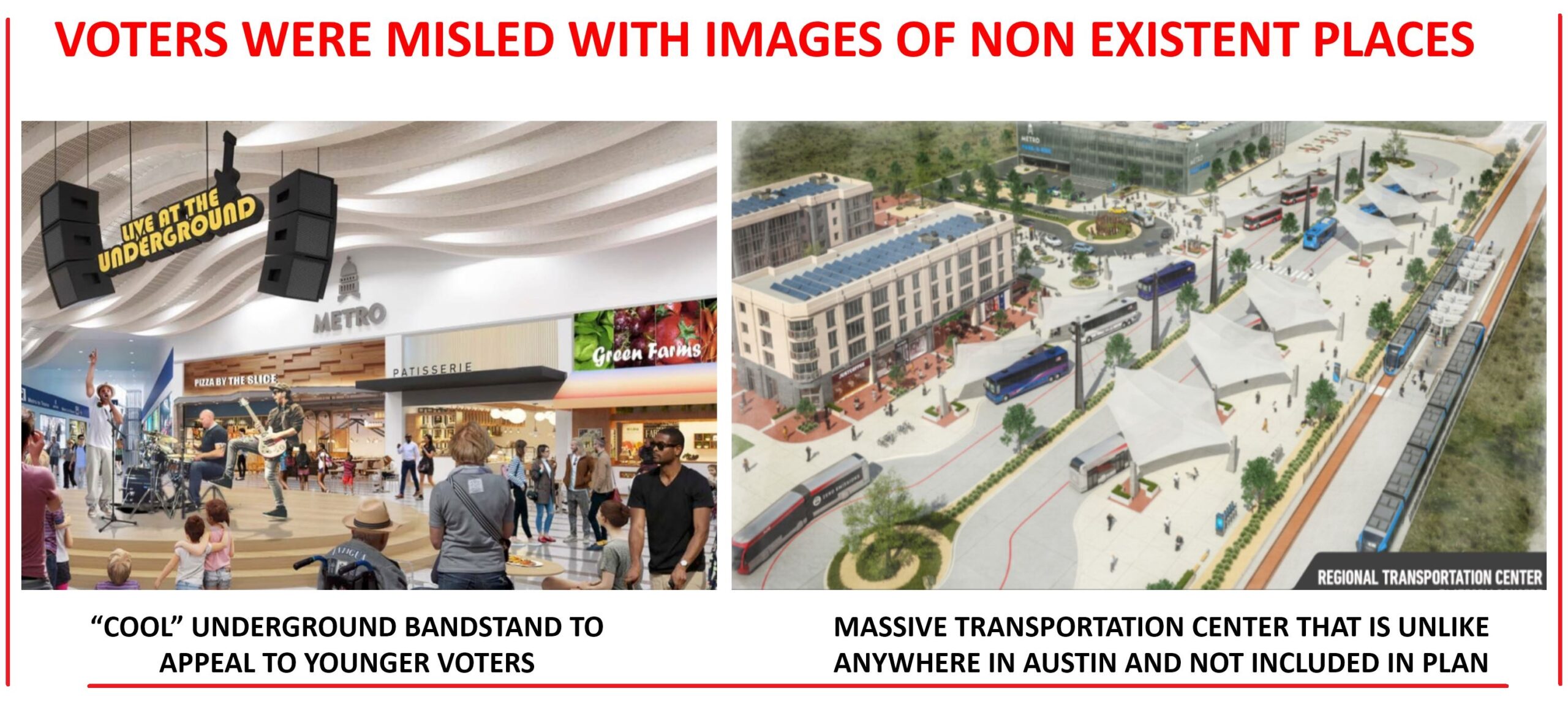
PANDEMIC RIDERSHIP LOSS
The current pandemic has decimated transit ridership for over two years, a lasting decline. Pathogen vulnerability makes packing disparate people in a confined space a transit killer. People have changed their commuting habits, work from home has eliminated hoards of routine commuters. More pandemics are in our future as are COVID variants; the latest one (Omicron BA), is the most transmittable yet.
Failing public transit has been dependent on temporary emergency bailout funding. It’s been propping up a vulnerable system, that runs mostly empty busses and trains and even in the best of times, was unjustified in a city like Austin.
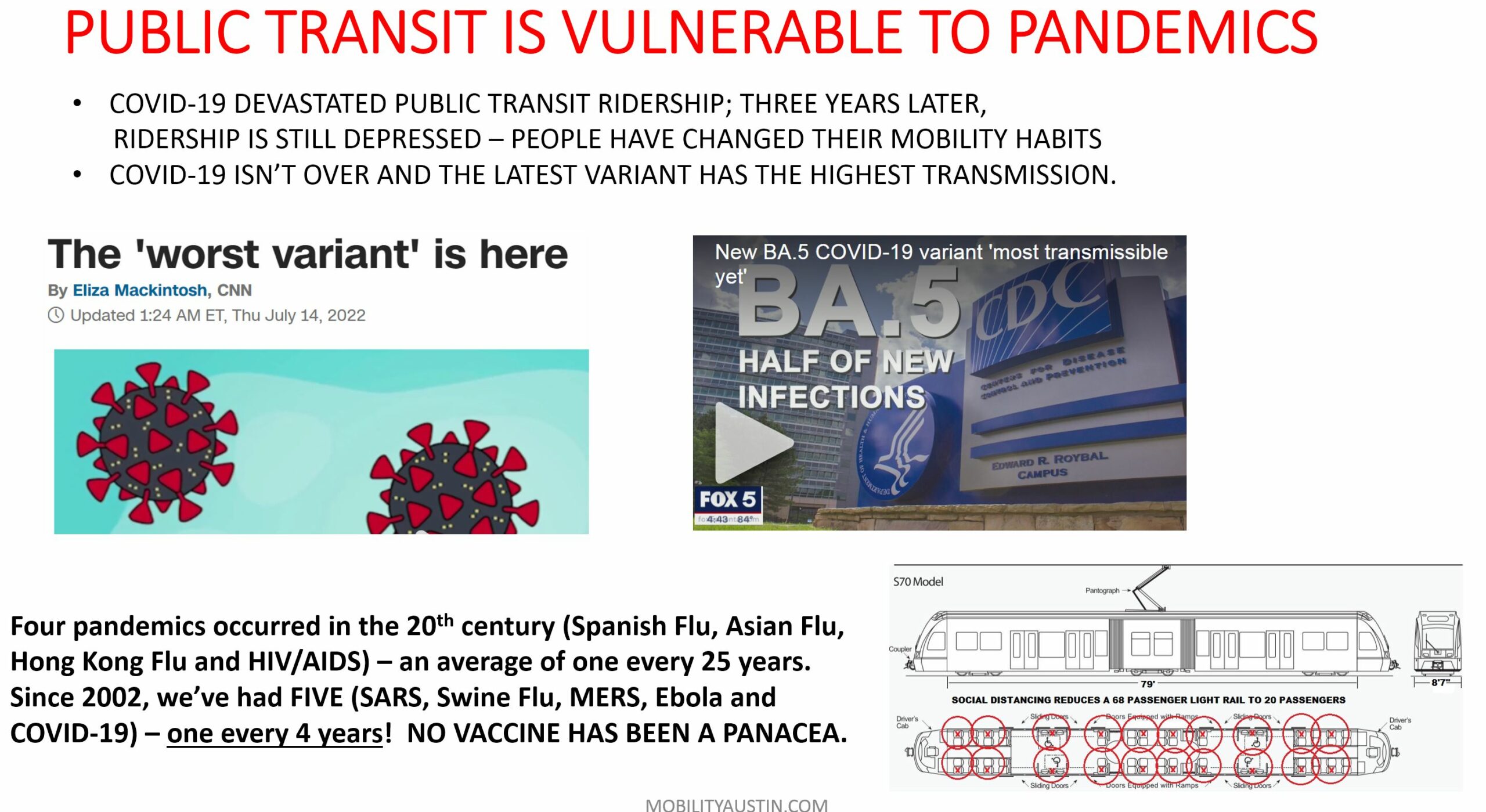
ProCON FUNDING IS A HOUSE OF CARDS
Federal fiscal policy promises tremendous inflation, rising interest rates make borrowing more expensive – currently $1.65 to repay every $1.00 borrowed. It will be years before tracks are laid, and inflation will continue to increase the cost of ProCON, something not reflected in proponents’ presentations along with the rise in real estate cost. Cost overruns will fall squarely on the shoulders of Austin homeowners and renters.
Austin has been coerced by a group of special interests into a massive mistake that further threatens Austin affordability and our Cities financial condition. Inflation, burgeoning government debt, FED interest rate hikes, Medicaid, Medicare and Social Security racing to insolvency, a continuing pandemic and a seething Federal borrow/spendathon, create a perfect storm.
The federal funding used to sell ProCON is competitive, uncertain, and expected from a government in crisis – far from the “done deal” purported by proponents.
Proponents claim ProCON operation cost will be funded by Capital Metro.
HOW?! Capital Metro doesn’t have a reliable, continuous revenue source for an extra $20 million a year, much less $200 million. It has no mechanism to increase that amount of taxes on the public. This cost will ultimately come from taxpayers and renters and will be in ADDITION TO the cost for the rail system itself. Capital Metro’s promised “contribution” to the Austin Transit Partnership was CUT BY ALMOST 2/3 months after the election. Ridership is in the toilet and the agency is operating on temporary COVID funds – that will soon end.
THE TAX RATE THAT MISLEADS VOTERS:
The city conceded in their 8/7/2020 resolution (page 6) that ProCON’s federal funding is contingent. Local taxpayers may find themselves accountable for the entire cost of ProCON. The city intends to collect the increased tax, regardless of the federal match, even though the light rail wouldn’t be operational for ten years or more into the future. The average value property will pay over $6,000 before the light rail moves its first passenger. Additional tax increases and borrowing will be required.
ProCON’s tax-rate increase was concocted to meet FTA grant rules that require a local maintenance and operation funding source, its amount will rise with your appraised value and compound future City tax-rate increases.
LIKE THE 2016 MOBILITY BOND, VOTERS ARE BEING MISLEAD WITH A FALSE NUMBER THAT IS INSUFFICIENT AND WILL REQUIRE MORE DEBT AND TAXES IN THE FUTURE. THIS WAS STATED, BUT QUICKLY GLOSSED OVER AND NONE OF THE MEDIA ASKED QUESTIONS.
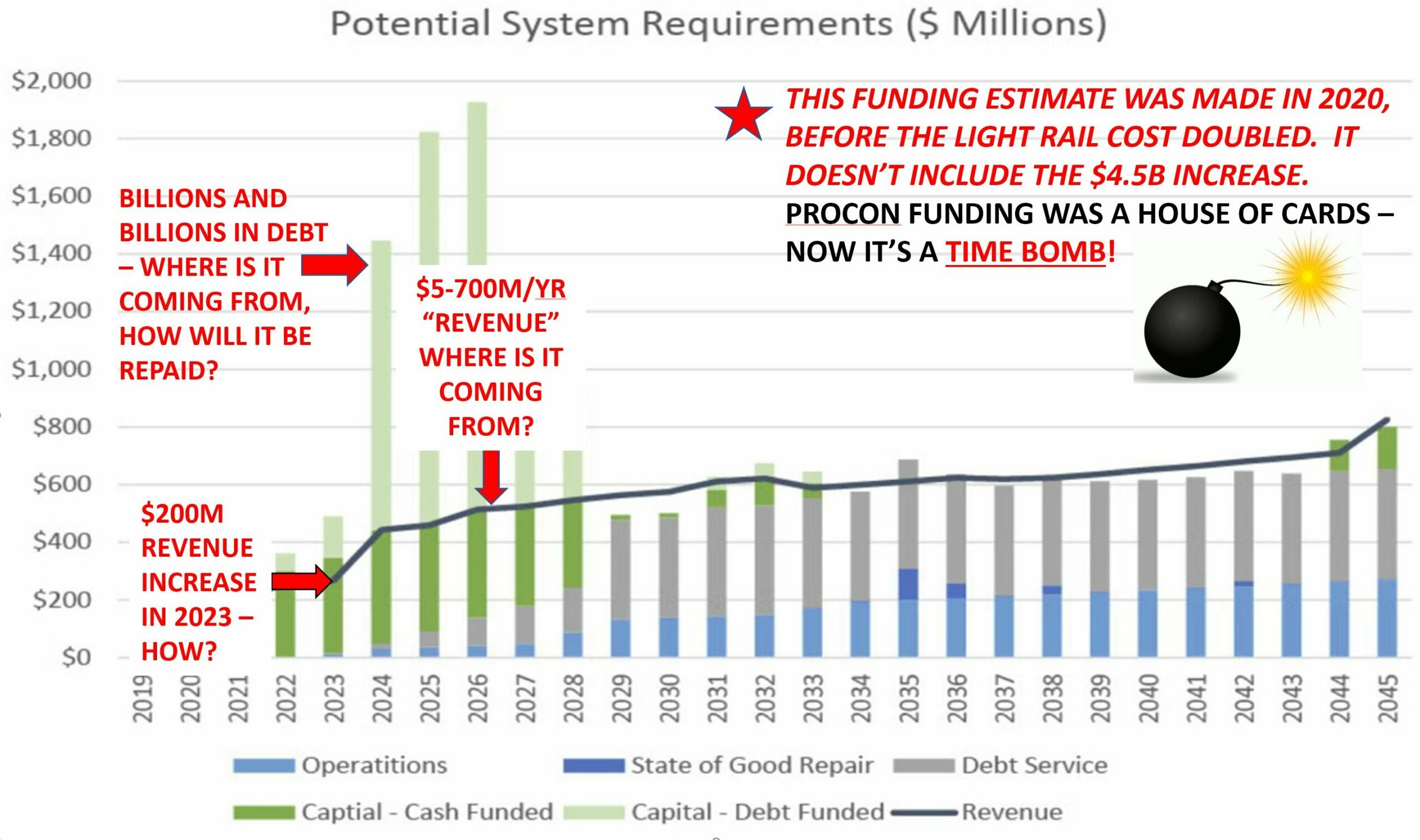
Simple math and public information show the amounts promised are misleading, mathematically incorrect, and grossly insufficient to fund the ProCON vision. They surveys and “public opinion” are built on on this misinformation and biased with transit enthusiasts responses, bringing ProCON’s “public input” into doubt. “Low ball” tax estimates and “creative” funding cannot change: 1) TOTAL program costs (I&S + M&O), 2) Tax base valuation, 3) Debt servicing costs, and 4) Resultant increases in property taxes and rent to fund the ultimate full cost. ProCON cannot be fully funded with a bond – it is so much money that it would exceed Austin’s safe borrowing capacity, jeopardize the city’s bond rating (which Moody’s already recently downgraded, because of city pension funding problems) and cripple future borrowing.
PANTS ON FIRE!!

ProCON COST KEEPS RISING
- RISING INTEREST RATES AND INFLATION
- INCREASED RIGHT OF WAY COSTS
- OUTRAGEOUS LIGHT RAIL COST = >$490 Million/Mile
- TUNNEL COST = $4.1 Billion
- OPERATING COST = $220Million / YEAR
- FULLY FUNDING $11.6B PROCON = >$2,400 / YEAR ON AVERAGE HOME
- SALES TAXES FUNDED OUR TRANSIT; PROCON ADDS PROPERTY TAXES
- 40-45% FEDERAL FUNDS ARE STILL NOT A SURE THING
- WHAT’S THE EVENTUAL COST? $12B? – $20B? – MORE?
Capital Metro spent MILLIONS in public funds to promote, advertise and market ProCON, efforts that went beyond public information, using strongly biased and contained specious content. All major newspapers, local tabloids, radio and television stations were showered with public funds to sell ProCON – it is any wonder there was little criticism, interest in the opposition points or questioning of the plan? These media outlets, for the most part, ignored the opposition and parrotted the talking points provided by Capital Metro. THIS SHOULD CONCERN EVERY VOTER!
In a stellar demonstration of “bait and switch”, the ATP is saying they will only have ONE rail line and that it will be years behind schedule. That and a 59% increased cost, is not what was voted on. It’s time to revisit this boondoggle.
Texas Deceptive Trade Practices Act Sec 17.12(a)
No person may disseminate a statement he knows materially misrepresents the cost or character of …. anything he may offer
HOMEOWNERS AND RENTERS SHOULD HONESTLY ANSWER TWO QUESTIONS:
1) Are you going to discontinue use of your car and shift to public transportation for your daily mobility needs?
2) Is ProCON worth over $2,000/year to you, particularly if you do not?
As population dramatically increased, Texas largest cities spent billions on rail and public transit. The result of their “investment”? Public transit ridership in Texas was lower going into the Pandemic than it was 20 years ago! Since the Pandemic, ridership has fallen by as much as half. Dallas and Houston’s prior Pandemic light-rail ridership was in decline for over two years, a trend mirrored nationally. This reality, based on empirical evidence, stands in contrast to the rosy ridership projections for ProCON. The facts speak for themselves: “high capacity” Metro Rail’s actual ridership is less than 20% of what Capital Metro promised, begging the question: Can we trust the rosy ridership projections for ProCON? Time consumption, inconvenience, contagion risk, and emerging superior mobility alternatives will continue to depress traditional public transit ridership.
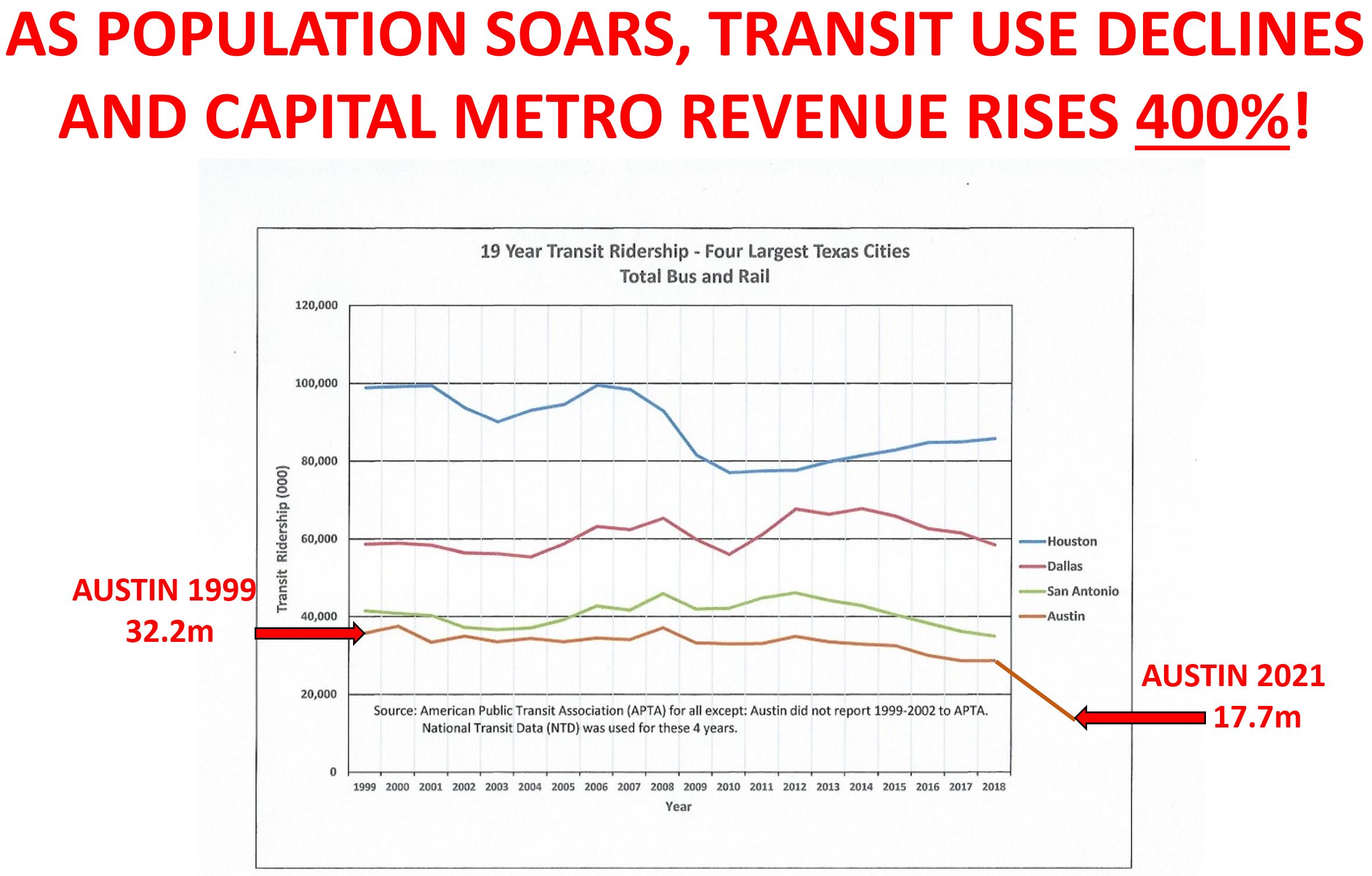
Nearly 90% of ProCON spending is for three, short distance, slow (average: 15-20 mph) trains that ultimately tap a power source driven by fossil fuels, including COAL. They are of no value beyond the limited and localized central city corridors they would serve. Light rail is a “one-trick pony” that fails to serve commercial needs, material/goods transport, service providers, police, fire, EMS, and most household trips. Additional bus routes of dubious value were thrown in ProCON to give the illusion of a larger service area. The reality is: almost all of the ProCON spending is confined to a small part of our community and short-changes most of our community.
ProCON’s massive consumption of local transportation funds assure continued neglect of the roadway network that serves the other 99% of our region’s mobility. Austin already neglects its roadway infrastructure – vital to our economy and way of life. THE $5 BILLION CITY OF AUSTIN BUDGET, INVESTS A PALTRY $49 MILLION FOR STREET AND BRIDGE REPAIR/MAINTENANCE; less than the cost to operate the Convention Center!
Light rail has not solved any American cities traffic congestion – ANYWHERE! America’s fourteen worst congested cities were duped by this false promise/sales pitch; ALL have growing traffic congestion WORSE than Austin, ALL have higher taxes to fund aging rail systems and ALL struggle to pay the exorbitant operating and maintenance expenses.
Austin lacks the density to support light rail. Cities where it works do. Austin has 3,200 people per square mile, compare that to these cities: Washington D.C. – 11,200, Chicago – 11,900, London – 15,300, Athens – 44,000, Tokyo – 16, 100, New York City – 27,000, Los Angeles – 7,000, San Francisco – 18,600, Seattle 8,000.
FURTHER SUGGESTED READING ON TRANSIT & TRAFFIC CONGESTION:
- https://pubs.aeaweb.org/doi/pdfplus/10.1257/aer.101.6.2616
- https://reason.org/wp-content/uploads/files/transit_utilization_traffic_congestion.pdf
- https://transfersmagazine.org/does-light-rail-reduce-traffic/
- https://citylab.com/transportation/2011/10/only-hope-reducing-traffic/315/
- https://sciencedirect.com/science/article/abs/pii/S0966692312002943
When commuters find congestion intolerable, many relocate closer to their job or find employment closer to home. That is why Census Bureau reports consistently show the average commuting time for most urban areas stays under 30 minutes decade after decade. In addition, the work-from-home shift accelerated by the COVID crisis, is having a big impact on commuting patterns and congestion.
ProCON will have no discernible effect on global climate change – no empirical evidence exists in support. Just the cost of the tunnel, could fund solar panels on every house in Austin. Unlike ProCON, that could really reduce Austin’s greenhouse emissions and at the same time, reduce or eliminate electric utility bills for most of our citizens. Austin could be a leader in renewable energy, affordability, and fighting climate change.
We must use reason and logic, particularly at a time of great change, and as Austin struggles with increasing inequity, cost-of-living, homelessness, and financial uncertainty. There’s a better way forward.
Public transit investment has had little return, as ridership is lower today than 20 years ago. As transit has declined, work-at-home has substantially risen. This trend has been drastically accelerated by the recent pandemic and results in less cars on the road and reduced traffic congestion – without massive debt.
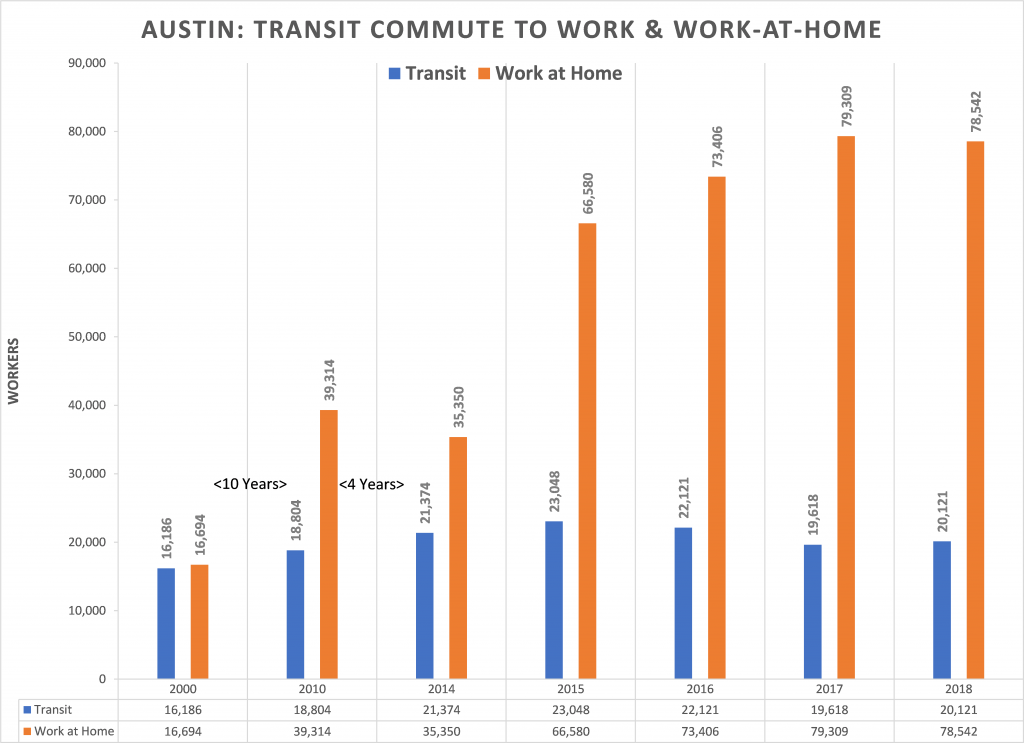
DOES ProCON LIGHT RAIL REALLY SERVE EMPLOYMENT?
Of the eight (8) employment growth centers (in purple) on the “Imagine Austin” map, ProCON light rail would serve the tip of only one.
Given the shift to work-from-home in recent months, are these employment centers even relevant anymore?
Source: Imagine Austin
Public transit isn’t the choice of workers, even when they live near it! It’s slow, takes too long to get to work, and steals your most precious resource: TIME!
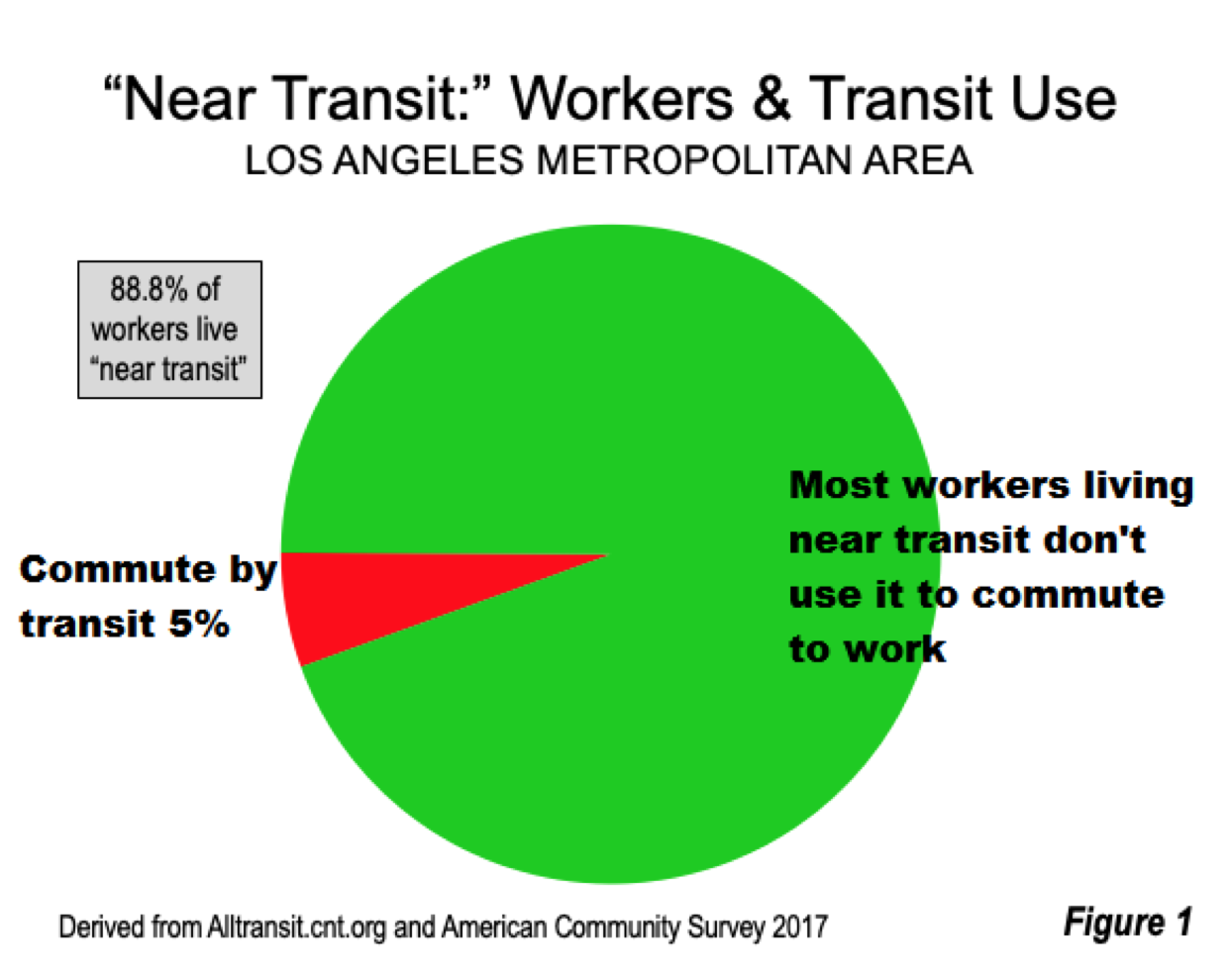
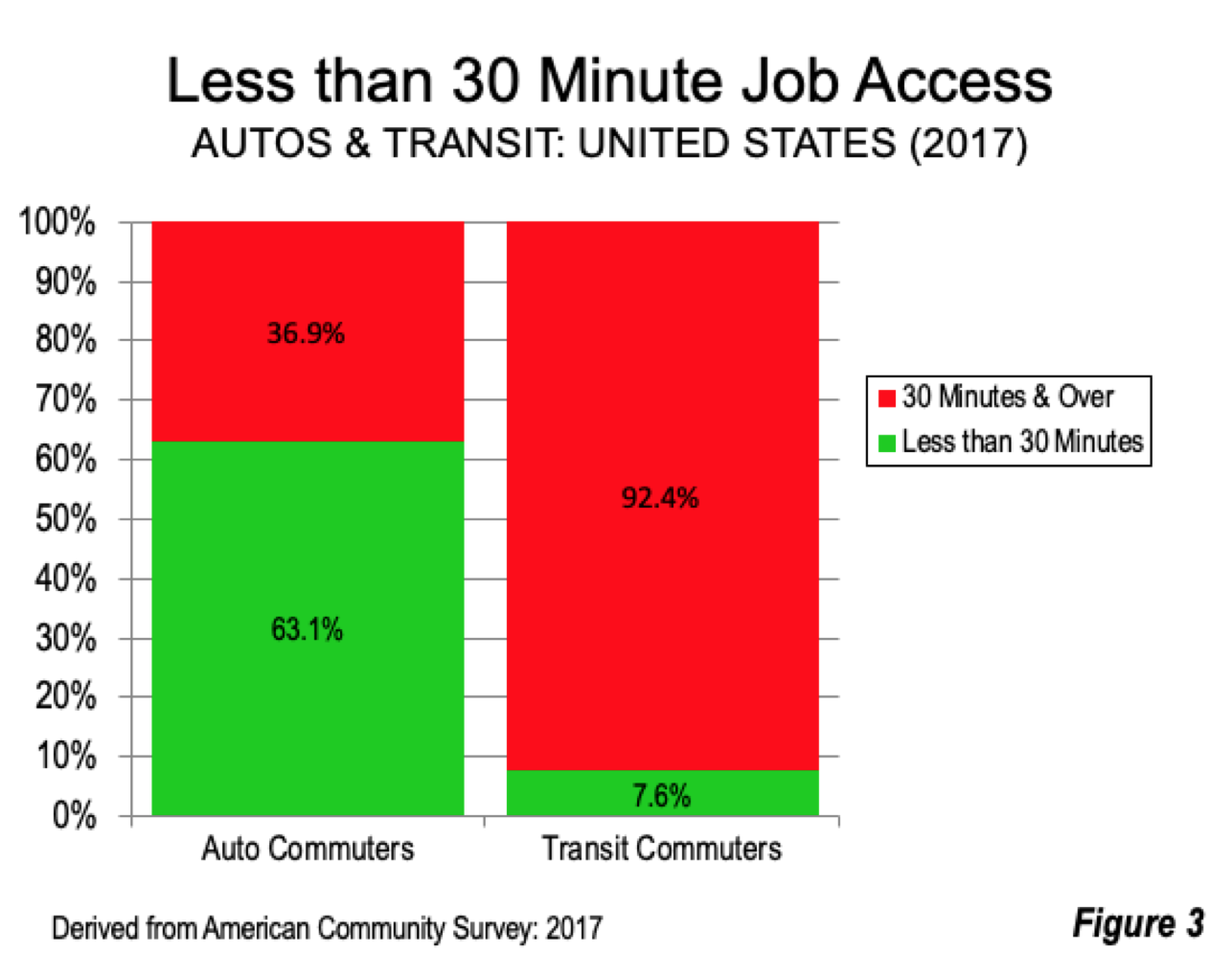
AMERICA’S 14 MOST CONGESTED CITIESAll paying higher taxes for aging light rail, that hasn’t fixed traffic congestion
|
A NEW MOBILITY

Our existing transportation network is in a state of evolution. Global, national, statewide, regional and localized transportation, are being transformed by technology. Most of our general transportation system, is built on old, inefficient technology. It’s a system at the mercy of human error and demand, as a result, it’s dangerous and often congested. Austin public transit is expensive, has low ridership, and with rare exception, is inefficient. We’re trapped in an “in-the-box” status-quo, driven by low-resolution thinking that is overdue for a transformative upgrade. Austin needs a holistic approach – a “New Mobility.”
The New Mobility transitions from fossil fuel to renewable, clean energy. Migrating both mobility and residential power demand to renewables, provides a one-two punch at climate change. A public investment in solar can also offer a path to greater affordability.
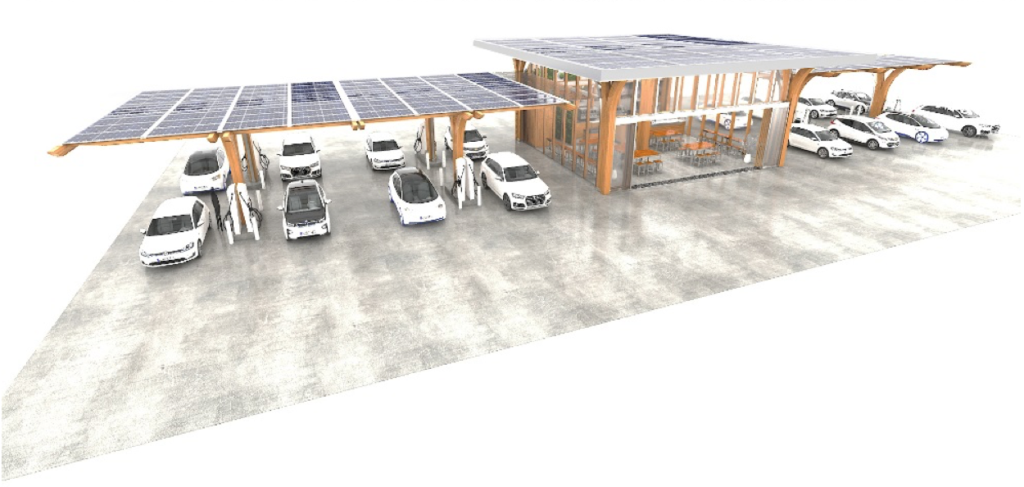
Source: renuteq
This paper focuses on the New Mobility components appropriate to our local transportation. They include express bus, autonomous bus, micro-transit, electric cars and micro-mobility all operating in a demand based environment. Fixed-Route/Fixed-Schedule is rapidly becoming obsolete, if for no other reason than its inconvenience. The New Mobility, particularly for local transportation, prioritizes convenient, On-Demand/Doorstep-to-Destination operation. The superior convenience, time savings, cleaner environment and greater efficiency of the New Mobility, make it the obvious choice. Why would we invest in obsolete transit that’s losing ridership, when new technologies are revolutionizing the industry?
The big picture is a seamless, hierarchal, transportation network, providing global mobility. A network that, at the long-distance level, includes new generation aircraft with improved efficiency and diminished environmental impact (See this video by NASA on new generation aircraft), high-speed rail between major population centers, regional express bus systems like VonLane, and perhaps at some point hyperloop transport.
At the local level, distributed, responsive transportation, scaled to demand will become the standard. It doesn’t require a twenty-ton pavement busting, 50 passenger bus to move a handful of 150-pound passengers. Unlike light rail, the New Mobility network is multi-modal, serves a variety of transportation needs and employs a diversity of tools. From commuters to first responders, service vehicles to transport of material goods, shoppers to recreation; all facilitated by the same infrastructure. Scaleable, shared, distributed, and electrified; there’s a better way forward.
The New Mobility includes upgrades to infrastructure that enable leaps in efficiency for existing roadways. It starts with V2X technologies to coordinate vehicles in motion. That includes speed, lateral movement, collision avoidance, vehicle spacing/distancing, weather condition adjustment and roadway information. The end result is less accidents, lives saved, smoother flow, and a reduction of traffic congestion in peak demand periods.
At the most basic level, a network of ‘Tri-Mode’ pathways can provide safe, efficient, localized mobility. These are essential conduits for pedestrians, bicyclists and electrified micro-mobility vehicles in the urban environment. These pathways can integrate V2X control to improve safety and coordinate utilization. Almost half of Austin’s urban transportation can be satisfied with micro-mobility – a staggering number of “cars-off-the-road” and reduced emissions. This shift alone would have over 100 times the impact on climate change of ProCON. To properly enable micro-mobility, we must design and implement specific infrastructure to meet demand and develop associated public policy. Our existing structure and policy is a patchwork, largely developed in reaction to a flood of scooters and special interest lobbying. We need a thoughtful, long-term vision to move us forward.
The New Mobility uses mobility hubs and passenger access zones. Places where mobility supply and demand can efficiently come together. These spaces can be built around community activity and parkland.

We can’t ignore the impact of the coming fleets of autonomous cars. This technology, promised five years ago, will exist five years from now; we appear to be mid-point in that cycle. It takes 8-10 years to deploy a status-quo, light rail system, huge change will occur in that time. Autonomous vehicles operating in an economic driven, mobility-as-a-service, shared environment will take cars off the road and provide unprecedented convenience.
To realize the New Mobility, we need to fund it. Widespread demand already exists; technology improvement will further energize that demand. We should freeze unused funding in the 2016 and 2018 bonds earmarked for transportation and pedestrian infrastructure. Much of that spending is based on decade old designs and don’t reflect today’s – and more importantly, tomorrow’s – mobility landscape. Another New Mobility advantage is much of it is funded by private entities, not tax dollars.
We must stop and consider how billions of dollars could fund a myriad of major, transformative projects that would benefit ALL our city – why would we settle for a single, dubious project that will (at best) only serve a small minority of residents in central Austin.
PUBLIC TRANSIT IN THE AGE OF PANDEMIC
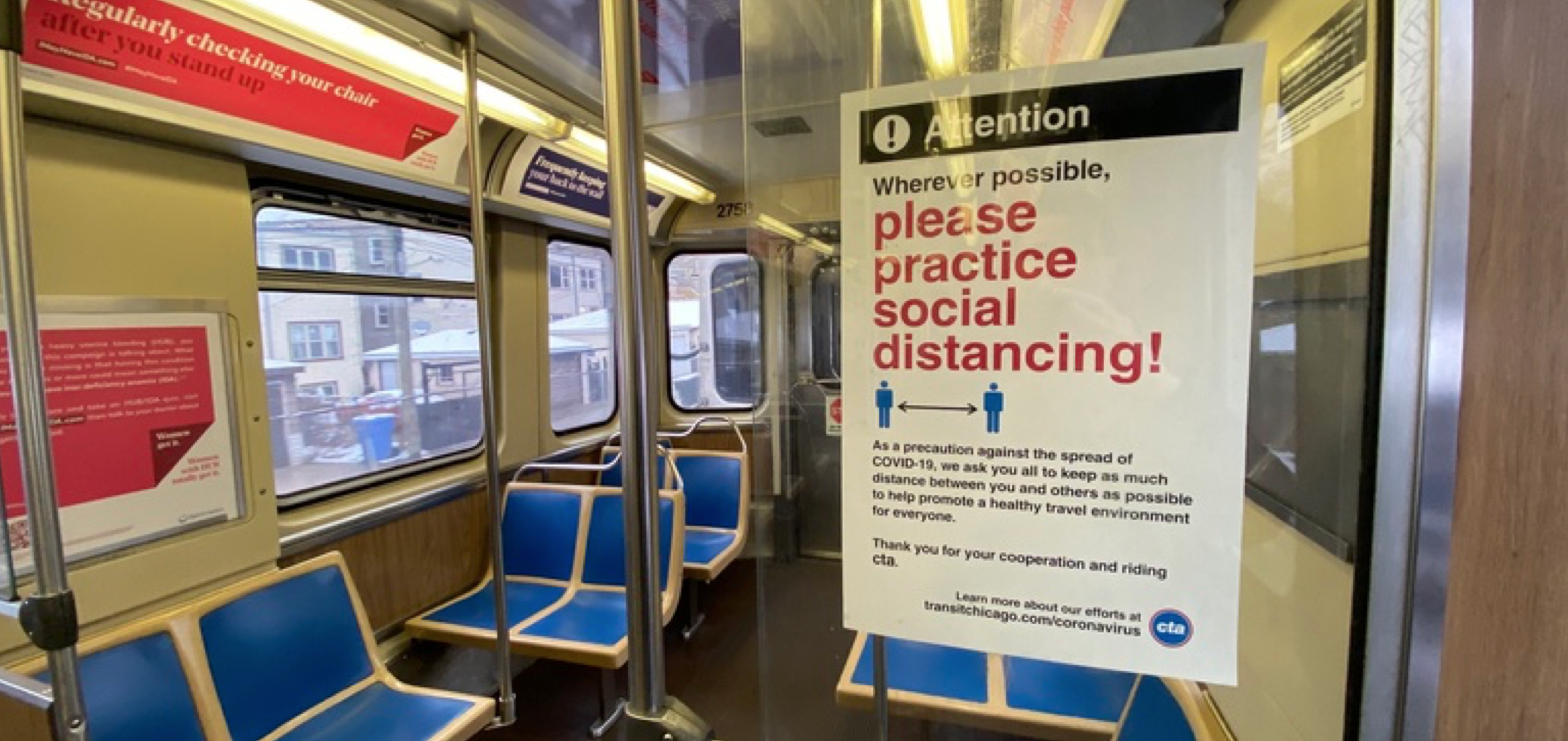
COVID-19 is our wake-up alarm; will we learn from it or hit the snooze button?
Public transit, particularly high capacity, put humans in close proximity – the antithesis of communicable disease mitigation and “social distancing”. Studies demonstrate most public transit vehicles harbor pathogens. No cleaning is absolute; the first infected passenger undoes it.
GET USED TO IT – COVID 19 and its variants, will be with us for a Long Time
A paper from the Yale School of Medicine states “COVID 19 can stay with us forever” https://medicine.yale.edu/news-article/24941/ Dr. Anthony Fauci states: “[a COVID vaccine] might not last forever and its effect will be finite“. He goes on to say: “We might need a boost to continue the protection, but right now we do not know how long it lasts…….the durability of immunity that’s protective ranges from three to six months to almost always less than a year” https://deseret.com/u-s-world/2020/7/8/21316087/coronavirus-covid-19-vaccine-booster CNBC reports in an interview with a noted virologist and former head of the CDC: “Even With a Vaccine, COVID is here to stay…… it might be with us forever” https://cnbc.com/2020/07/28/even-with-vaccine-we-will-be-dealing-with-this-forever-virus-experts.html
We don’t know the future of COVID 19 or other pathogen, a reality that makes investing huge sums into public transit a reckless endeavor. Perhaps even more disturbing, due to climate change and other factors, pandemics are increasing in frequency; what will the NEXT pandemic bring?
THE LESSON OF NEW YORK?
COVID19 cases in New York City, appear to largely correlate with public transit and population density. New Yorkers, many of whom don’t own a personal vehicle, are forced to accept health risk for mobility. No easy answer exists for a stranded, public transit dependent population, other than to avoid creating the problem in the first place. In the first few months, COVID infected over 4,000 MTA workers and 131 died – numbers that imply public transit contagion.
Related read: “The Subways Seeded the Massive Coronavirus Epidemic in New York City”
“…They stand on station platforms and at bus stops, nervously waiting for rides in confined spaces with strangers — prime conditions for spreading the virus. They board thinking the virus could be lurking anywhere — on subway poles, bus seats or floating in the air around them from another passenger’s uncovered cough or sneeze.”
– Washington Post
IS MASS TRANSIT COMPATIBLE WITH “SOCIAL DISTANCING”?
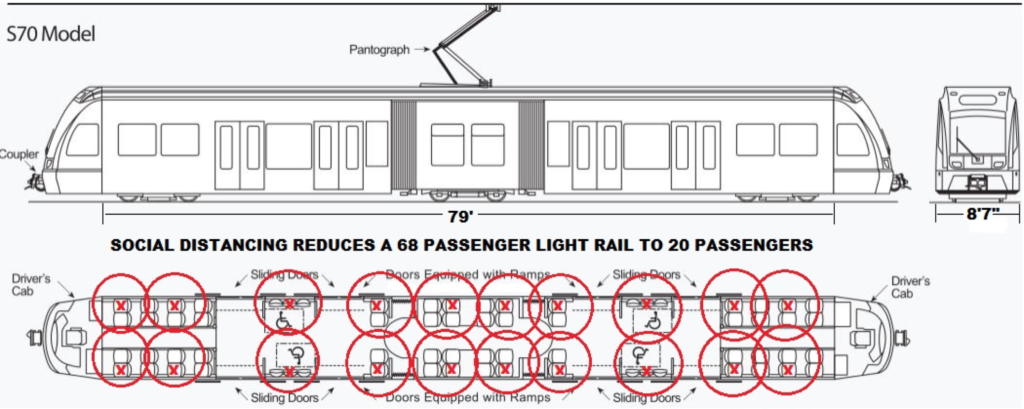
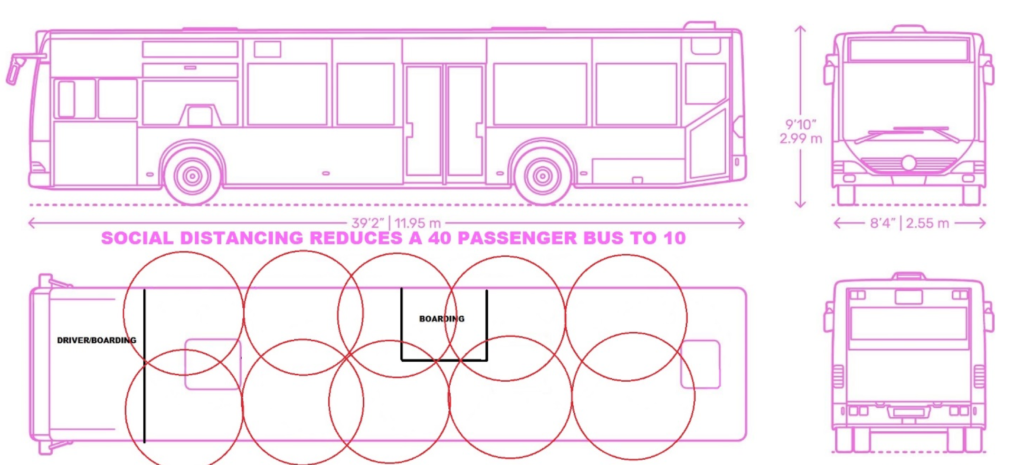
Most Capital Metro vehicles do not have openable windows, limiting fresh air circulation in the confined cars. The majority of filtration systems are ineffective against COVID-19 and many other microscopic pathogens.
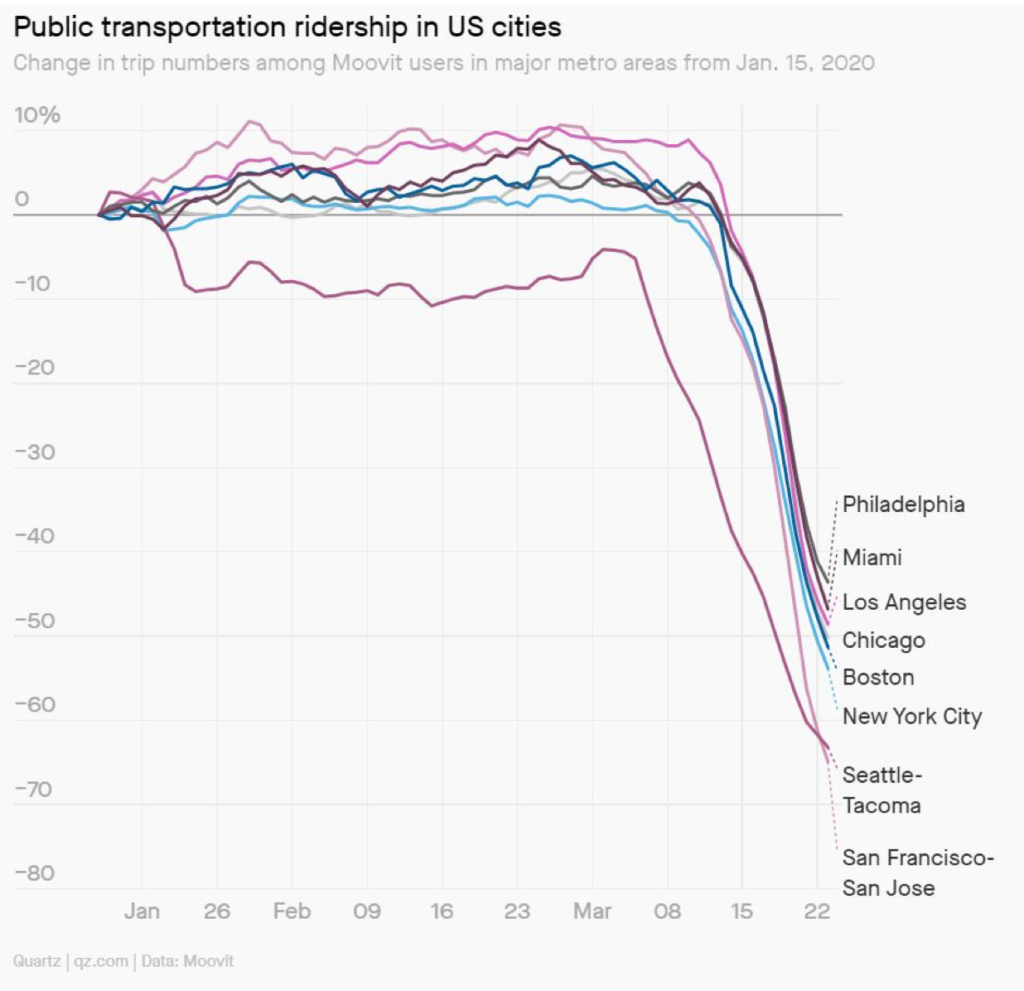
PANDEMICS ARE OCCURRING AT A HIGHER FREQUENCY
Four pandemics occurred in the 20th century (Spanish Flu, Asian Flu, Hong Kong Flu and HIV/AIDS) – an average of one every 25 years. Since 2002, we’ve had FIVE (SARS, Swine Flu, MERS, Ebola and COVID-19) – one every 4 years!
Spanish Flu killed over 50 million people (675k in the U.S.); since that time, global population has grown over 400%. Medical experts warn that more lethal pandemics are coming, along with antibiotic resistant staph “super-bugs”; it’s not a matter of “if,” but “when.” As risk increases, so must our defense.
“Today, worldwide, there is an apparent increase in many infectious diseases, including some newly-circulating ones (HIV/AIDS, hantavirus, hepatitis C, SARS, etc.). This reflects the combined impacts of rapid demographic, environmental, social, technological and other changes in our ways-of-living. Climate change will also affect infectious disease occurrence.”
– J Patz / World Health Organization
“I think what we’re looking at now with SARS-CoV-2 [COVID-19], is that process of becoming a new seasonal human pathogen. And so, in that sense, humans will be with this virus forever.”
– Prof. Paul Kellam virology professor, Imperial College
COVID-19’s effect on traffic congestion and air quality, provide insight into the future benefits of work-from-home, micro-mobility, renewable energy and electrification. It also brings an awareness that public transit and high-density development, can provide fertile ground for viral transmission. COVID-19 has decimated public transit ridership, will be with us for some time to come and could become endemic.
COVID-19 is shown to have more dire effects on people of color, many of whom use public transit. Public transit disproportionately exposes this demographic to a potential high contagion environment, with greater risk for infection.
Knowing what we know now, borrowing billions for a transit system, so vulnerable to communicable disease, makes no sense. The New Mobility’s distributed, lower-density model is far less susceptible to these failings.
DRIVER EDUCATION
Of all the things we can do to reduce traffic congestion, improving driver skill is top of the list. It comes at little cost and provides a lot of bang for the buck.
Traffic congestion is typically a result of two things: 1) Roadway displacement by excess vehicles, and 2) Human error. Significant mobility improvement can be economically achieved through driver education.
Common bad behaviors:
- Following too closely
- Speeding
- Excessive lane changing
- Failure to obey roadway rules/marking
- Last minute travel decisions
- Vindictive driving
- Distracted driving
These are major contributors to our traffic congestion and accidents. Many of these issues will increasingly be mitigated by on-board safety technologies, all of them will be resolved by widespread V2X (defined on next page) roadway coordination.
What can we do today? First, begin running public service announcements to educate drivers. Second, increase penalties for failure to follow the guidelines.
V2X
Of all the evolving transportation technologies, V2X (Vehicle to Everything) promises the greatest change in the short term. V2X communication, is a way for cars, trucks and other vehicles on our roadways, to coordinate with their environment and each other. Federal Pilot programs, to prove and refine this technology, have been ongoing in a number of cities for years. V2X functions on several platforms: On-board, Dedicated Short Range Communication (DSRC), Cellular (C-V2X), Millimeter Wave and 5/6g networks.
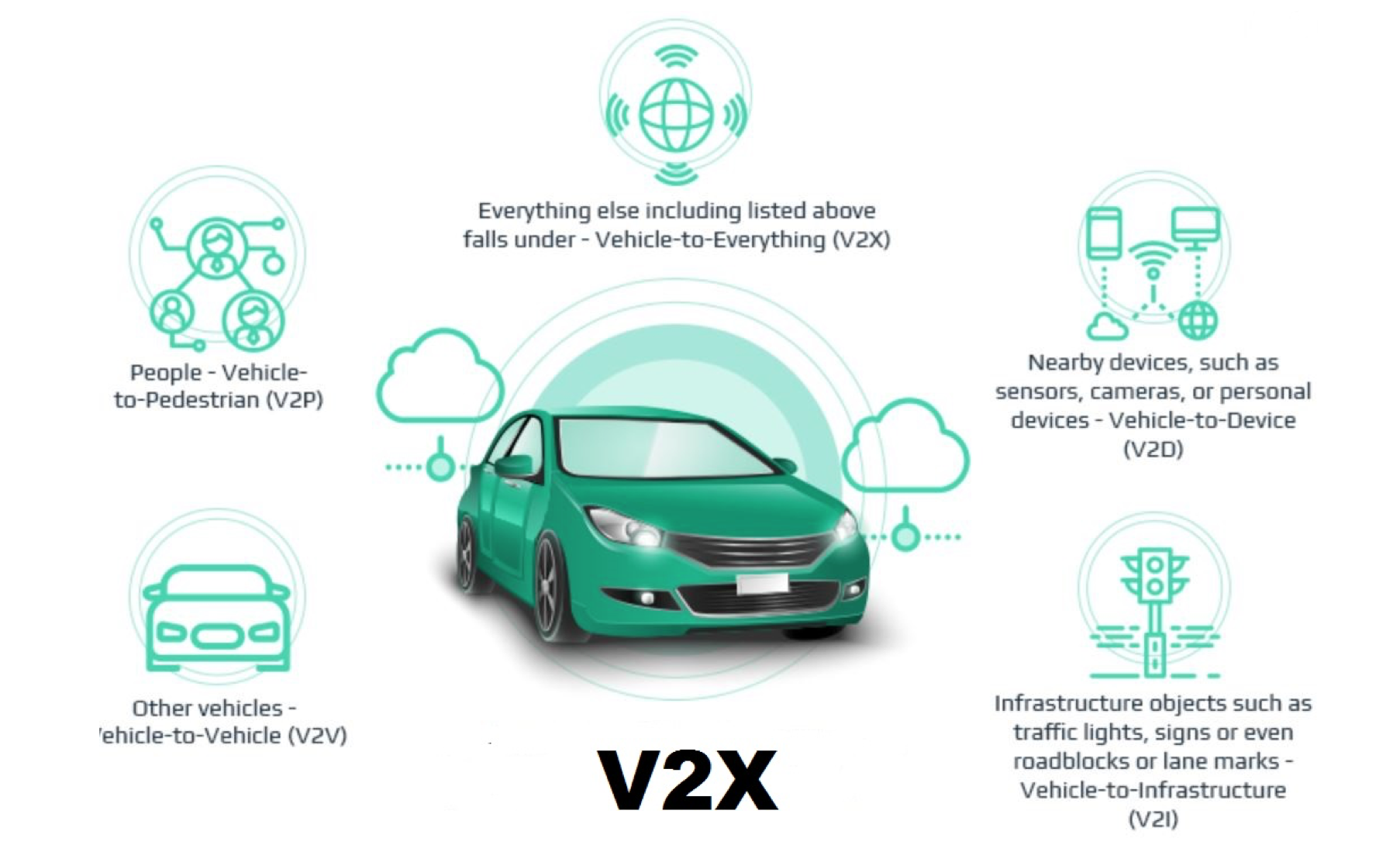
Source: Intellias
If improved roadway safety and less congestion is your goal, here’s the answer. This technology will progressively and profoundly change the flow of vehicles in our city. Benefits include safety, reduced travel time, accident reduction and a cleaner environment. By imposing overarching control on vehicles, combined with redundant, on-board safety systems as a back-up, we can enforce uniform speed and operating distances. V2X will provide dynamic routing based on current road/traffic conditions, enforce collision avoidance and provide information on infrastructure, pedestrians, travel conditions and weather.
On-board, V2X type functionality already exists in many vehicles and is becoming standard on new production cars. Advanced Driver Avoidance Systems (ADAS) currently offer collision avoidance, lane keeping, blind spot/lane change alert/avoidance, anti-lock brakes, adaptive cruise control and automatic braking.
V2X has recently been considered for a Vehicle Mileage Tax (VMT), this is intended to replace or augment the federal gas tax. As vehicles become more efficient and electrification increases, the existing gas tax will be even more insufficient in funding our highway infrastructure. The tax at $0.18 per mile has not increased since the 1993 and falls tens of billions short annually. This is just one of the coming tax increases Americans can expect as our burgeoning debt expands from massive government spending, inflation, fixes to existing entitlement programs (Medicaid, Medicare, Social Security) are imposed and interest rates escallate from FED policy correction. V2X is now being seen as a way to track vehicle use and apply a tax against it.
Austin Transportation had the foresight to recruit a nationally known expert in this technology for our city. He has specific talents in the area of V2X and is already at work implementing the technology. Expect 15 V2X intersections this summer, with dozens more coming. That’s a bright spot, let’s build on it. Austin has been chosen as a test site for C-V2X hardware testing to begin in September. We are one of three U.S. cities selected for these important OEM equipment testing. This indicates Austin, will be in the forefront of this major technology that is transformative for our mobility.
5-6g COMMUNICATION
5/6g will usher in one of the greatest technological leaps in our lifetimes. Austin should be at the forefront of this ‘next generation’ of digital communication. For mobility purposes, 5/6g will provide a foundational communication layer that enables connected transportation to function at a high level.
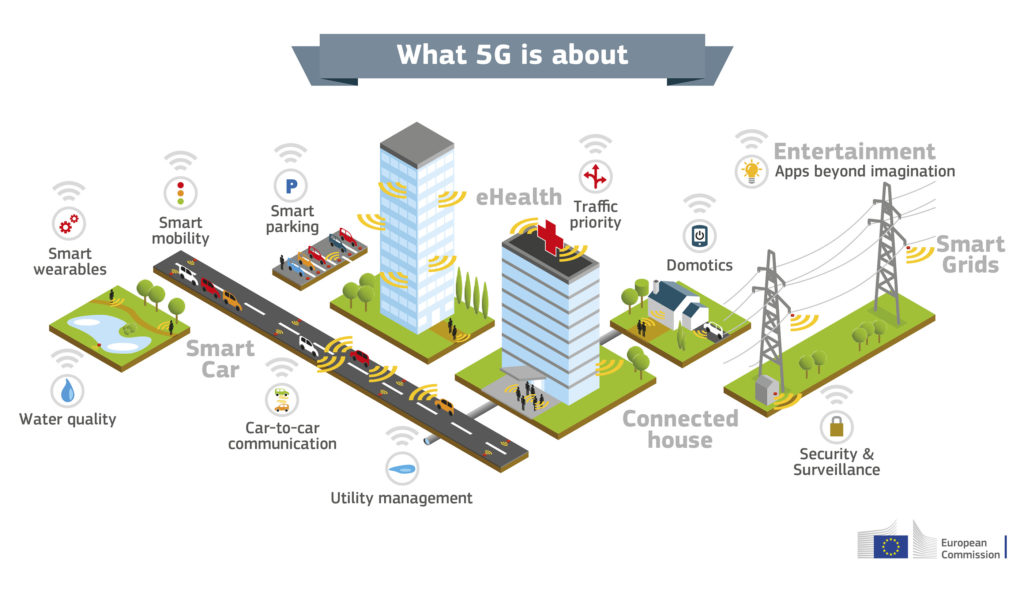
Austin should remove all roadblocks to 5/6g implementation and lead in its deployment. High-speed data transfer is vital for low-latency applications like V2X. Adoption of evolving technologies like V2X and the “Internet of Things” (IoT), will demand even greater bandwidth, including millimeter wave transmission.
The recent COVID-19 crisis has underscored our reliance on digital communications. The shutdown will have lasting effects on our society and applications like work-from-home and e-commerce will demand more bandwidth. That demand will increase as we re-orient society in response to this crisis and in the future.
There are a some who are suspicious of 5g and believe it is a conspiracy or that it has dire health effects. The good news is there is very little to no evidence to support those beliefs. The science shows that the positives of 5-6g communications far outweigh any risks.
5-6g will require a great number of transceivers to provide robust, wide area coverage. These “antenna” sites need to be coordinated and authorized in the public sphere by government. We need to get going.
Images: systemoneservices.com and Geospacialworld.net
To show real leadership, we could go one step further: create a citywide, 5/6g municipal network with access for all citizens. Like water and electricity, data has become a vital resource for our community, and the faster the better.
Let’s make high-speed data access a public utility and provide it in an equitable fashion. Higher data rates offered by 5/6g, open the door to a smart, connected Austin and improved mobility. The shift to a distributed workplace environment will further expand demand for this resource as commuter mobility demand contracts.
An “Austin Network” could provide content and functionality for our entire city and assure internet equity for all citizens regardless of income and neighborhood. For less than the cost of the Blue/Gold Line, we can implement this service – a service that affordably serves ALL our citizens and parts of our city with this vital resource.
Besides offering low cost Wi-Fi to citizens, the ‘Austin Network’ would handle huge amounts of data and the many functional bits-and-bytes for control and monitoring systems. Security, network integrity and physical implementation, will require work, but 5/6g is the coming future. Mission-critical services and applications, like Internet of Things (IoT), Blockchain/Tangle, power grid and transportation control will be a priority, while others, like smart meter readings, are less time-sensitive. Our ‘Austin Network’ must be both flexible and scaled to the various services based their respective needs.
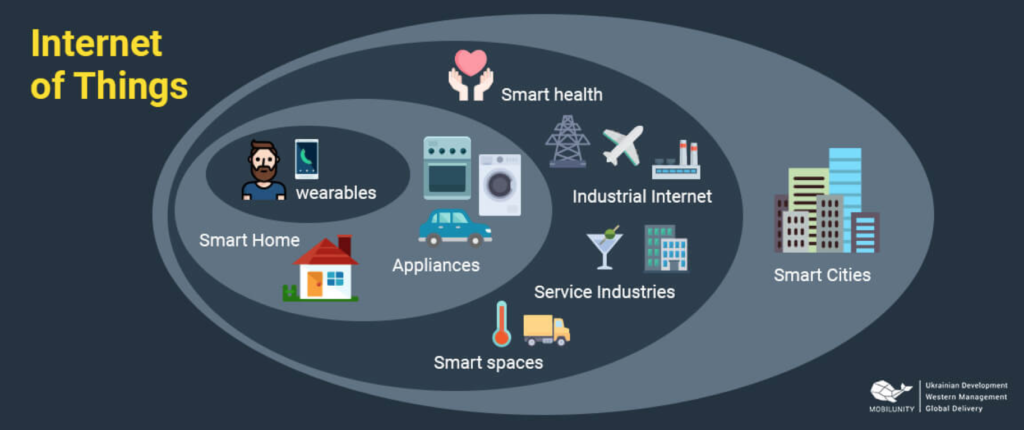

Some interesting things developing in the high speed data communication world:
DEDICATED SHORT RANGE COMMUNICATION (DSRC)
Dedicated Short-Range Communication (DSRC) is a wireless communication protocol designed to allow automobiles in the intelligent transportation system (ITS) to communicate with other automobiles or infrastructure technology. DSRC technology operates on the 5.9 GHz band of the radio frequency spectrum and is effective over short to medium distances.

DSRC offers secure, low latency, high reliability that supports interoperability. It receives very little interference, even in extreme weather conditions, because of the short range that it spans. This makes it ideal for communication to and from fast-moving vehicles.
Competition over radio frequency spectrum has put 5.9Ghz DSRC in a rivalry with 5/6G and cellular. C-V2X, initially proposed by Qualcomm, which uses cell phone 5/6G is quickly emerging as a replacement.
MOBILITY-AS-A-SERVICE (MaaS)
Imagine a world where most people don’t own cars and use vehicles on-demand. It’s predicted that in ten years, only a quarter of Americans will own a car and the MaaS (mobility as a service) market will be worth $1.76 trillion. Intel announced at the 2020 Consumer Electronic Show that it’s going “all in” on MaaS.
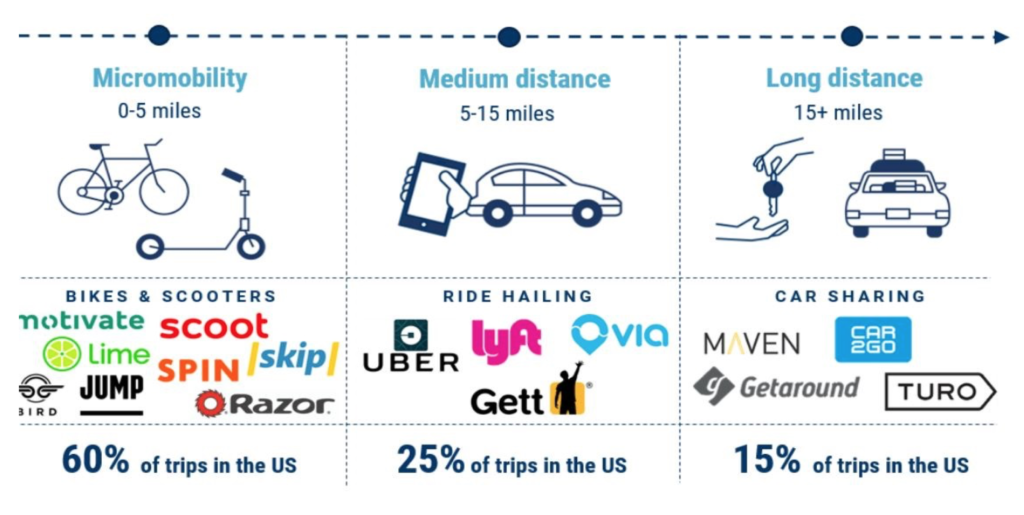
Source: CBInsights
Sophisticated vehicles will be produced, fielded, and maintained for public conveyance by fleet operators. Maintenance will be done by trained technicians in special facilities to assure the vehicles are fully functional and compliant with coming standards like V2X.
We are in the formative years for this service; Uber, Lyft, rental bicycles, and scooters are all early on-demand, public MaaS offerings. As pervasive as they are today, they’re baby steps to the future. These more exclusive options provide less exposure to pathogens, have less surfaces exposed to contagion and unlike public transit, can be sanitized in the field, resulting in a cleaner, safer transportation option.
MaaS offers the ultimate equity, vehicles are available to all citizens in all parts of town. Low income riders can benefit from subsidies, based on Median Family Income and funded by existing public transit taxes that currently go to CapMetro. We can finally achieve true transportation equity and equality with a superior on-demand/door-to-door system.
MaaS is a distributed, on-demand, real-time platform that can include any combination of transport methods such as car and bike sharing, robo-taxi, micro transit, and car rentals/leases, and provides everything for the consumer from travel planning to payment.
Subscribe to an app and you could have access to a scooter, bike, car or a transit pass, for however long you need it. The end result is a more convenient and affordable method of getting around.
- Easy route planning— Real-time route planning allows users to plan journeys often using multiple modes, based on intelligent suggestions tailored to personal preference.
- Simplified payments— MaaS users can pay for transportation using phones, smartwatches and bank cards, before or after their journey, or on a subscription basis. It eliminates physical payment, where contagion is a concern. Subsidized ridership benefits can automatically be entered into the system, making a more frictionless process for low income travelers.
- The personal touch— MaaS is a fully personalized service that builds relationships between users and the transport providers. By using big data, two-way communication and constant user feedback, MaaS systems become the ultimate customer-focused transportation platform. User needs and routines are defined and the appropriate services made available.
“Breakthroughs in self-driving cars are only the beginning: The entire way we travel from point A to point B is changing, creating a new ecosystem of personal mobility. The shift will likely affect far more than transportation and automakers —industries from insurance and health care to energy and media should reconsider how they create value in this emerging environment.“
– Deloitte, The Rise of Mobility as a Service
SHARED MOBILITY
Source: Alphabet
People riding together = cars off the road. Viability of shared, fixed-route/fixed-schedule systems, like light rail, is handicapped by their logistical and physical shortcomings. They offer good service to the few who live along their fixed paths, but are too inconvenient for everyone else. Unless you have extremely high density, something that doesn’t exist in Austin and is unlikely to ever exist here, they cannot reach their ridership potential. Those riders are captive to the fixed schedules and numerous stops and starts made by rail systems.
Artificial intelligence coordinated, application based, on demand/point to point ride sharing, overcomes those impediments. Modern ride sharing software, powered by artificial intelligence, can match riders by destination, demand and travel window – from anywhere in the city at any time. Ridesharing and carpooling, foster efficient, less cars-on-the-road, commuting; expanding this segment of mobility should be a priority.
Ride Hailing – Transportation Network Companies (TNC)
Uber, Lyft and other TNC’s have had profound impact on our transportation. They are early symbols of the emerging, On-Demand/Door to Door, transportation age.
Development of ride hailing software and its capabilities to coordinate transportation requests provides a foundation piece of the on-demand New Mobility.
Because they encounter a fraction of the disparate ridership of public transit, sanitized TNC vehicles offer a safer and more convenient alternative. Vehicle cleaning doesn’t require a special facility and most service can be performed in the field. Less surfaces, less passengers and easier servicing offers safer mobility.
Eventually we will see autonomous shared services in the ride hailing industry. Waymo, Zoox and others are already exploring this space. This will increase efficiency, reduce ridership cost and decrease congestion. It will also devastate inconvenient public transit.
Shared Access Vehicles (SAV)
Vehicle sharing will become more commonplace as time goes by. The average personal automobile sits unused most of the time. Vehicle sharing can make vehicles more efficient by extending their service time; lowering the cost of mobility. A purchased vehicle can become an investment, where the owner obtains a return from its use by others.
Car Clubs
Car clubs can reduce the cost of mobility. Vehicle cost and utilization shared among members is common practice in aircraft and recreational watercraft. Traditional rental companies and manufacturers are getting involved, with Hertz, Enterprise, Ford and BMW recently investing in or acquiring car clubs. Clubs can provide a more personalized transportation experience for people who can afford to upgrade to more exotic vehicles. The concept already exists with entities like Dream Cars and the Houston Motor Club.
MOBILITY HUBS/PASSENGER ACCESS ZONES
As simple as a street corner, or elaborate as a specialized plaza. Mobility hubs consolidate supply and demand into one location; a “mobility marketplace.” This consolidation, reduces starts and stops and encourages shared use across modes. Most importantly, these hubs can be located where demand actually exists, not on artificial transit corridors designated by bureaucrats to accommodate obsolete fixed route public transit.
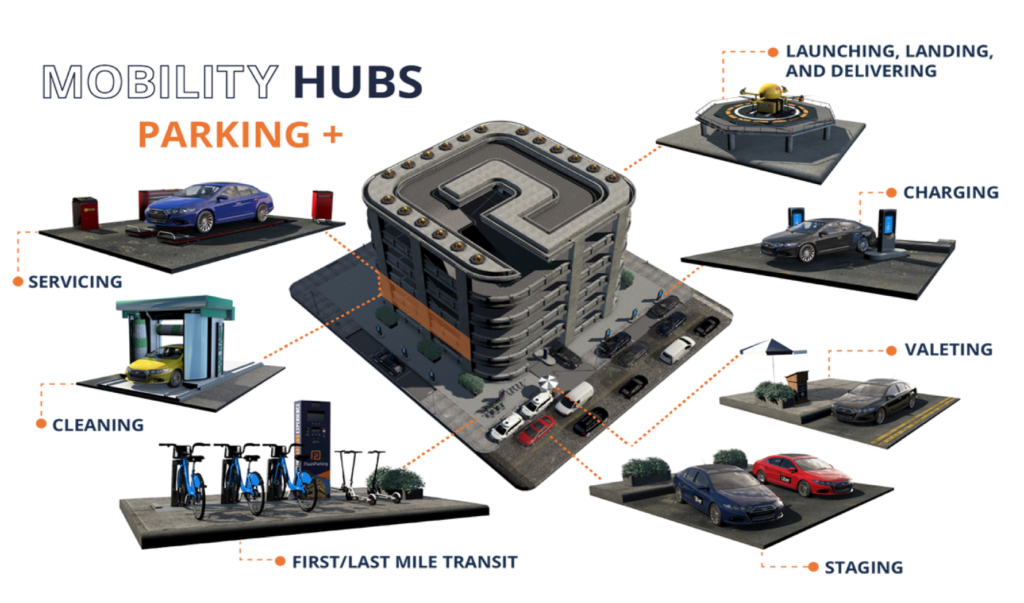
Source: Flash Parking
Combining multiple modes of transportation together in one physical location has many advantages. Typical components include carshare stations, robo-taxi access, bike parking, wayfinding elements, docked bicycle & scooter access, charging stations, public transit, and consolidated pick-up/drop-off points. The result is more ride sharing, micro mobility, less automobile use and cars off the road.
Austin-based Flash Parking is an emerging leader in this space. They re-purpose existing parking facilities into Mobility Hubs, combined with traditional parking, that frees up curb-space for alternative use.
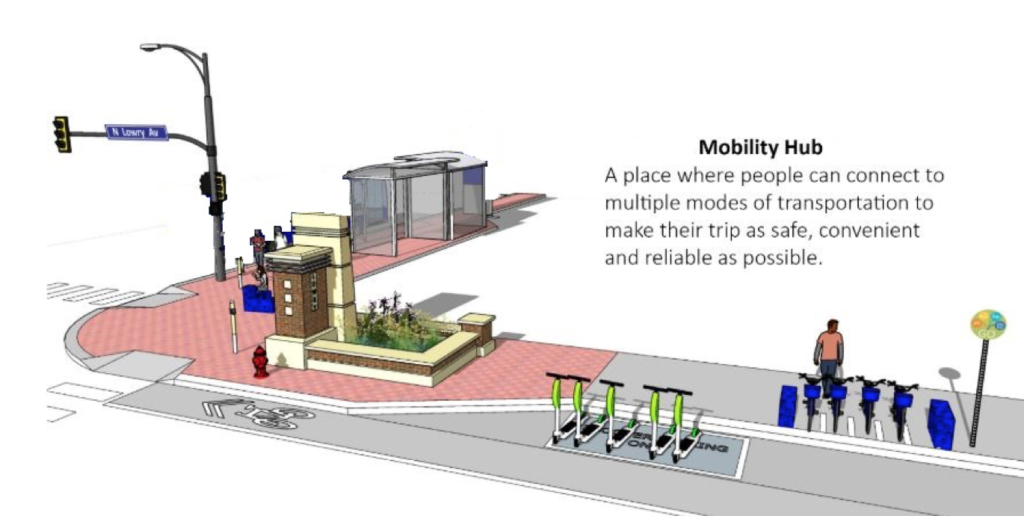
A BETTER USE FOR THE ORANGE LINE FUNDING
For the cost of the Orange Line light rail, we could do the following:
|
MICRO MOBILITY
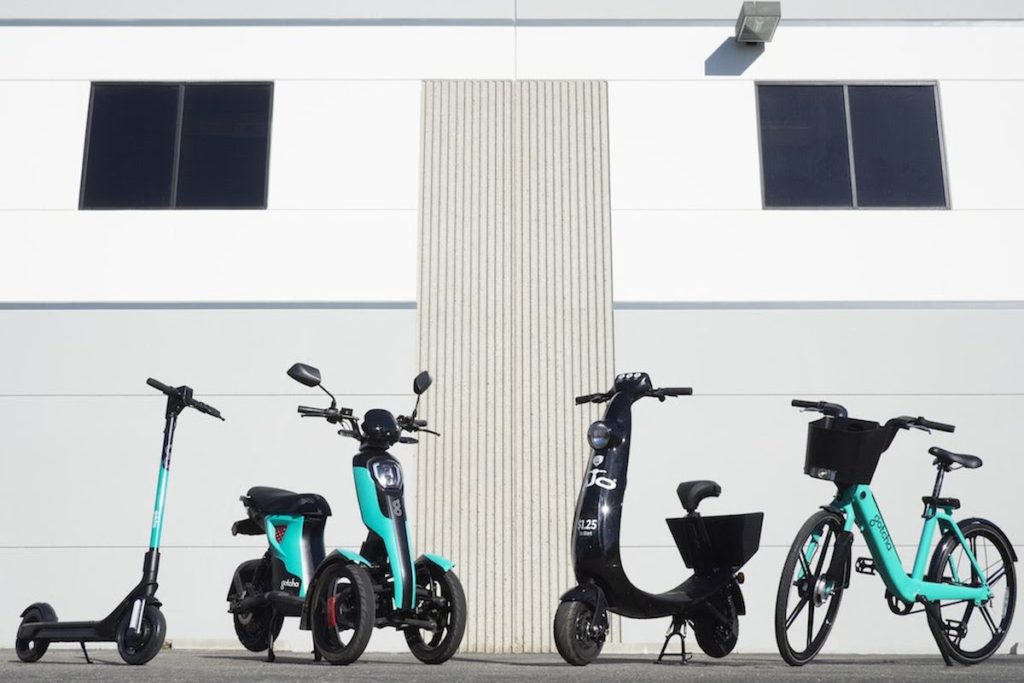
Half of car trips span less than five miles, making them ideal for short-range travel options like Micro Mobility – a major player in the New Mobility. It has the potential to reduce cars on the road by 40% or more in urban settings. Austin is a perfect fit for Micro Mobility, a study by INRIX shows Micro Mobility can potentially satisfy 45% of Austin’s urban travel.
INRIX TOP 25 CITIES FOR MICRO MOBILITY – Austin is 21st

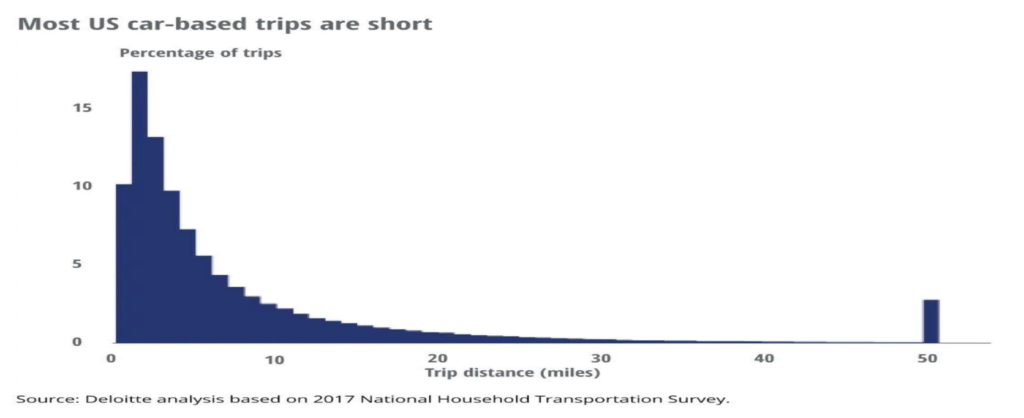
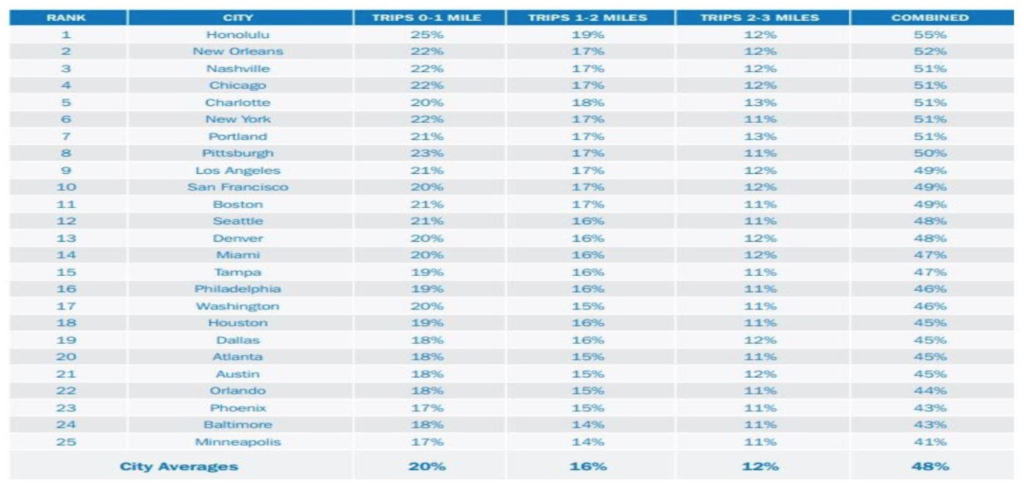
This growing form of transportation utilizes smaller, single-occupant vehicles like docked and dock-less bicycles, e-bikes, tricycles and electric scooters. They reduce the footprint needed to move people short distances and take cars off the road. Micro Mobility reduces reliance on the automobile and fight greenhouse gas emissions at the same time.
AUGUST 2020 – NEW REPORT SHOWS Micro-Mobility is on the rise and emerging as a disruptor of mobility. Read this report here: https://ghsa.org/sites/default/files/2020-08/GHSA_MicromobilityReport_Final_1.pdf
Micro Mobility vehicles are typically compatible with bicycle lanes and can greatly expand the usefulness of this existing infrastructure. As cities face population growth, moving more residents through existing transportation networks becomes a greater challenge. We must think beyond bicycle lanes.
Austin needs to wake up and get serious on micro mobility. We need regulatory policy that assures responsible, safe operation that includes:
- Safety equipment – helmets
- Registration of owned vehicles
- Audible signaling and lighting
- Liability insurance
- A city insurance pool for low income users to join
- Rules on storage/placement of vehicles
- Right-of-way rules
- Distracted operation rules
- Speed limit
- Appropriate enforcement
We have made a good start with the All Ages and Abilities program, but it needs to go much further to support our future micro mobility demand. Conceived in 2014, this program needs to recognize the transition of micro mobility over the past six years. Powered scooters, skateboards and e-bikes need greater right of way and regulation if they are to be operated in the same space as human powered vehicles and pedestrians.
“What is needed are consistent, simple and easy-to-understand rules that promote safety and balance the needs of all road users. At the same time, the rules must be flexible enough to accommodate new devices that are likely to appear in the future” – GHSA MicroMobility Report
Funds exist from prior bonds for urban trail and bicycle infrastructure, can be dedicated to help create micro-mobile pathways. Before another foot is paved or designed, we should make sure all future infrastructure is tri-use compliant (Bicycle/Pedestrian/Micro Mobility) wherever possible. Austin should be a leader in designing for micro mobility. Bollards along Shoal Creek put homeowners and motorists at odds with the bicycling community, and are an inferior band-aid that is substandard for long-term future mobility. We can do better.
These pathways should be specifically designed for this new generation of mobility. To attract significant ridership, they must be safe and inviting. Most importantly, they must be functional and practical. These pathways should constitute a logical network that allows reliable travel with a minimum of interruption through the demand areas of our city.
For a minuscule portion of ProCON’s cost, we can create a world-class, dedicated micro mobility pathway system; let’s lead, not follow. While inexpensive alternatives exist (bollards, paint), it makes no sense not to do it right. Resources that serve a greater demand justify greater investment. Here’s an op-ed by the founder of Bird scooters on dedicated micro-mobility infrastructure: https://bird.co/blog/prioritize-third-lane/
If the city wants to realize its vision in the Strategic Mobility Plan this will be a key component. It has already begun: https://data.mobility.austin.gov/micromobility-data/
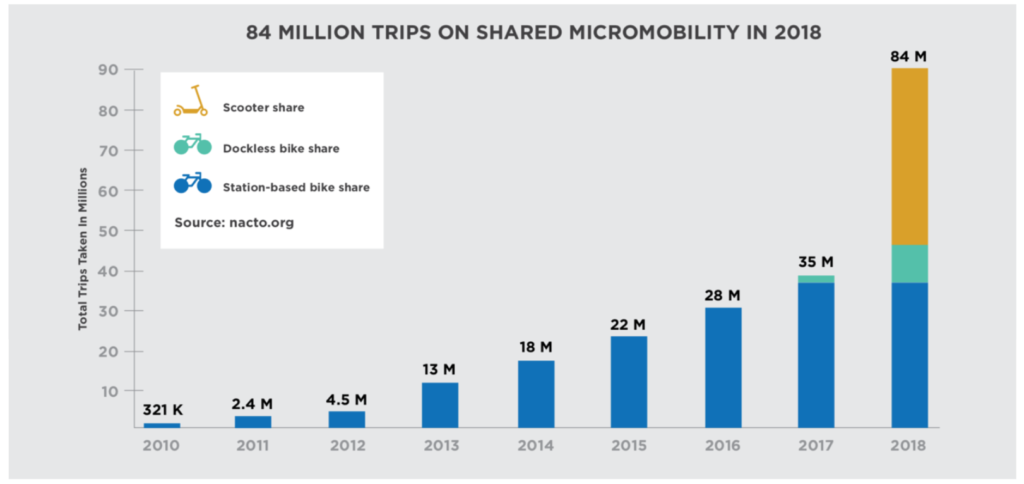
Source: National League of Cities
A BETTER USE FOR THE BLUE LINE FUNDING
For less than the cost of the Blue Line light rail, we can implement a first class, illuminated, V2X enabled, tri-modal network throughout our city, designed to support Micro-mobility. We have one big problem: No vision from local leaders who appear ignorant of this revolution. Rather than continue to fall further behind in this mobility transition, Austin could be a global leader in Micro-mobility and bicycle infrastructure; setting a standard for others to follow. Micro-mobility already moves more Austin citizens than Capital Metro. A safe, secure inviting network for recreation and commuting, will take far more cars off the road than the train. A localized Blue line only serves a small segment of our city; a comprehensive tri-mode trail network, would provide ALL Austinites infrastructure they will actually use and benefit from. Finally, a community project of this magnitude would create significant employment, more bang for the buck, have greater CO2 reduction, move more citizens and reduce more traffic congestion than ProCON ever could.
|
BICYCLES, E-BIKES AND TRICYCLES
Bicycles are, within the constraints of weather, an excellent short/moderate trip option for the physically enabled. Electric motor assisted bicycles (E-Bike) extend the user base and range.
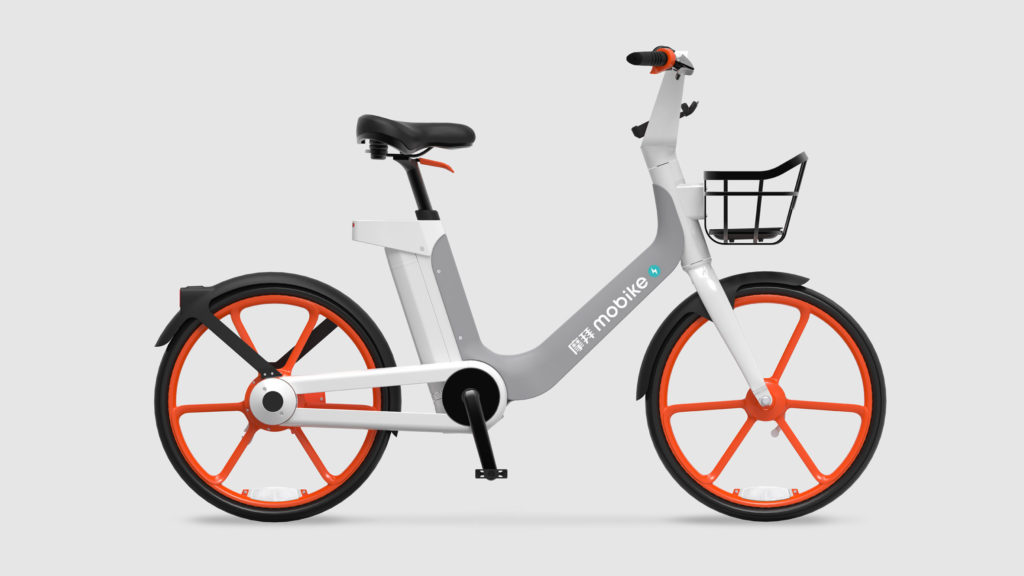
E-Bikes classification developed by the Bicycle Product Suppliers Association and PeopleForBIkes lays out legal concepts and a three level ‘low-speed electric bicycle’ classification system:
- A “class 1 electric bicycle” or “low-speed pedal-assisted electric bicycle,” is a bicycle equipped with a motor that provides assistance only when the rider is pedaling, ant that ceases to provide assistance when the bicycle reaches the speed of 20 miles per hour.
- A “class 2 electric bicycle,” or “low-speed throttle-assisted electric bicycle,” is a bicycle equipped with a motor that may be used exclusively to propel the bicycle, and that is not capable of providing assistance when the bicycle reaches the speed of 20 miles per hour.
- A “class 3 electric bicycle,” or “speed pedal-assisted electric bicycle,” is a bicycle equipped with a motor that provides assistance only when the rider is pedaling, and that ceases to provide assistance when the bicycle reaches the speed of 28 miles per hour, and is equipped with a speedometer.
HOW MANY E-BIKE ARE SOLD EACH YEAR IN THE U.S.? 600,000 were sold in 2020, they constitute the fastest growing segment of bicycle sales, with approximately 75% year over year growth.
HOW MUCH DO E-BIKES COST? Entry-level e-bikes start about $1,200 and can rise to over $5,000 or more. As adoption rates and competition rise, prices will fall.
CAN E-BIKES BE SAFELY OPERATED ON BIKE PATHS? Yes. Based on research, e-bike riders exhibit similar safety behavior to riders of pedal powered bicycles. They travel faster when riding on roadway (+1.8 mph), but actually slower than regular bikes riders when on bicycle paths (-1 mph).
Source: peopleforbikes.org
SCOOTERS
Stand up platform “kick” scooters provide the most visible form of Micro Mobility in Austin. Bird, Lime, and others have inundated our city with these devices. While hurdles still exist in the area of regulation and safety, they are here to stay.
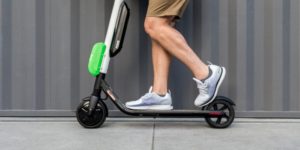

Scooter technology is improving and larger, electric powered, sit down scooters, with cargo capacity are available. India, Spain, China and France are leaders in their use. They will soon be common in American urban environments. Let’s get ready!
PERSONAL MOBILITY/OTHER – SEGWAY, HOVERBOARD, SKATEBOARD
This class of vehicle allows portable transportation that can function in both pedestrian (sidewalk) and bicycle/micro-mobility pathways. It’s a class of transportation, that is seeing tremendous development, declining cost and increasing range.
Segway/Ninebot is a major producer of equipment and produces many of the kick scooters in the market (like Bird and Lime). They are committed to Micro Mobility and developing exciting products that will expand this market.
“You don’t need a 4,000lb vehicle, to move a 150lb human a couple of miles.” – Dean Kamen, Segway
E-MOTORCYCLES & ROAD TRI/QUADCYCLES
A next step up from scooters, these vehicles are capable of highway speeds, two passengers with greater range, and cargo capacity. In many countries, small displacement motorcycles and sit-down scooters are ubiquitous for short-mid range transportation. Because of higher speed and capacity, they are more for use on general roadway infrastructure and incompatible with micro mobility pathways that share bicycles.
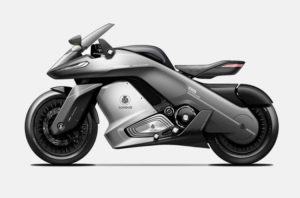
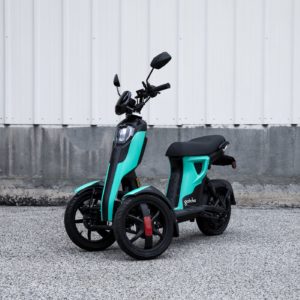
Electrification and rapidly advancing on-board technologies are also improving this class of vehicle. Antilock brakes, stability control, collision avoidance, traction and other ‘ride by wire’ systems can enhance safety.
MUST WATCH: VISIONARY TALK ON MICRO/URBAN MOBILITY
TRACKLESS ELECTRIC TRAMS
With far more capacity than a ‘bendy’ bus and a sophisticated suspension system that eliminates the roadway issues that plague buses, this new high capacity system is now being tested. Many transit experts believe it can replace light rail at a fraction of the cost. Benefits include, easy re-routing, no need for expensive rail bed, elimination of much of the disruption during construction and a sophisticated, quieter rubber tire advanced hydraulic undercarriage that gives a rail smooth ride. A rechargeable battery system eliminates the costly and unsightly, overhead cable power system. Proponents claim it is 1/10th the cost of light rail and can operate in both a dedicated or shared guideway.
MICRO TRANSIT
Micro Transit consists of vehicles that typically serve 16 or less passengers. They operate in a distributed environment, that can include fixed routes and schedules where justified. ProCON would continue the status quo, running large, usually empty, “one size fits all” buses to fixed destinations. That kind of stale thinking is ceding way to Micro Transit that scales to ridership and destination demand.
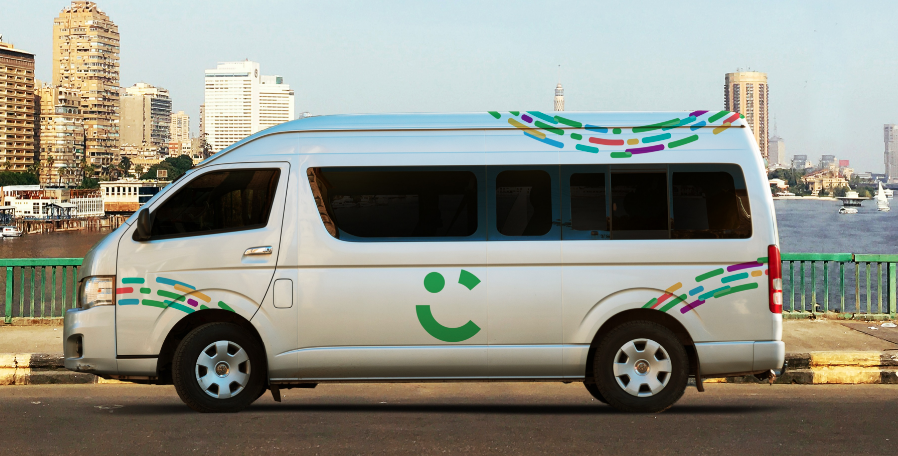
Transit agencies and numerous private companies like Bridj, Uber, Dollar Van, Via and others, are already migrating to micro transit solutions around the world. Superior service using small-scale, on-demand vehicles that offer flexible routing. Ideal for commuter “ride pooling” and mobility hub group pickup application, they offer greater efficiency, lower emissions and diversity of operation, things no large bus or rail transit system can provide.
PRIVATE SECTOR – Corporate shuttles allow businesses to move employees between company locations and can offer express commute services on an exclusive V2X pathway.
Firms like Via and Transloc offer small vehicle pick-up services and circulators providing mobility in urban areas for profit. Think of it as the “missing middle” in commuting and transit.
“Driver-only buses are worse than single occupant automobiles.”
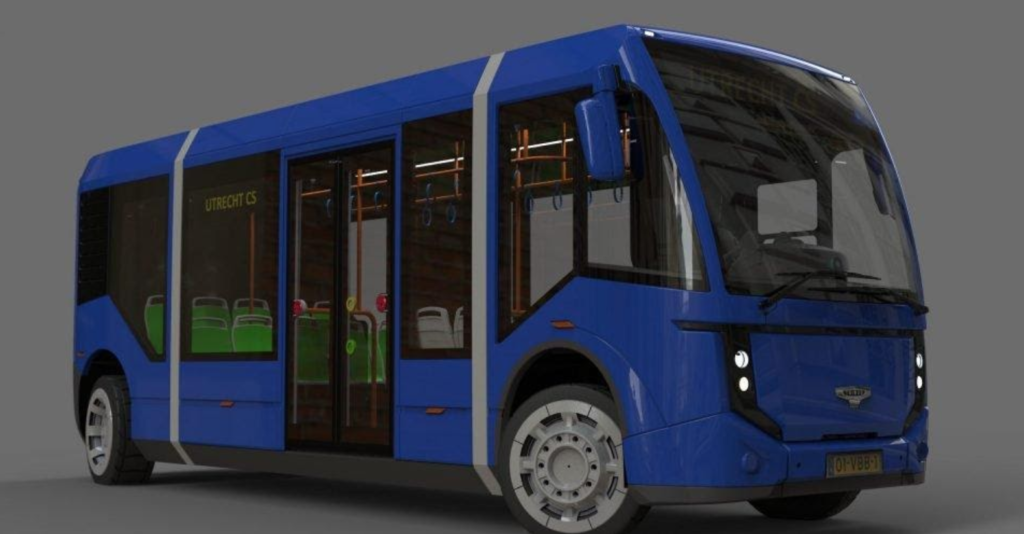
PUBLIC SECTOR – CapMetro runs a lot of empty buses around Austin. This is particularly true during non-commute hours. It’s time to move to smaller vehicles operating in a distributed on-demand model. Vehicles like Toyota’s ‘E-Pallet’, a small, 12-passenger electric vehicle can do double duty for delivery of goods. CapMetro could also invest in docked vehicles and offer them at transit stops or mobility hubs where they frequent, for last/first mile solutions or short trips under 5 miles.
AUTONOMOUS VEHICLES
Source: Smart Cities World
A coming revolution is on the horizon. Of all the impending AI based technologies, autonomy will have the greatest impact on our mobility. It is a game changer on the scale of the horse and buggy to automobile transition of 100 years ago. Level 5 autonomy is already proven technically achievable, under controlled circumstances. New federal guidelines are encouraging this transformation (USDOT AV 4.0) and standards are evolving.
Regrettably, autonomy has been over-sold by enthusiasts over the past decade, fostering unrealistic expectations and subsequent criticism. Make no mistake, however: hundreds of billions of dollars fuel this transportation revolution with major companies like Google, Intel, Ford and GM planning their futures on it. Like any complex technology, it takes time to get it right. It’s still early, but autonomous vehicles will be commonplace before ProCON is completed.
Corporate and manufacturer-owned fleets of autonomous vehicles, appear likely to dominate this form of transportation. These will be vehicles people use, as oppose to own. There are economies of scale for maintenance performed in a fleet environment. Improved efficiency in mobility, a smaller universe of vehicles, and micro mobility will expand the capacity of our roadway infrastructure and reduce travel time.
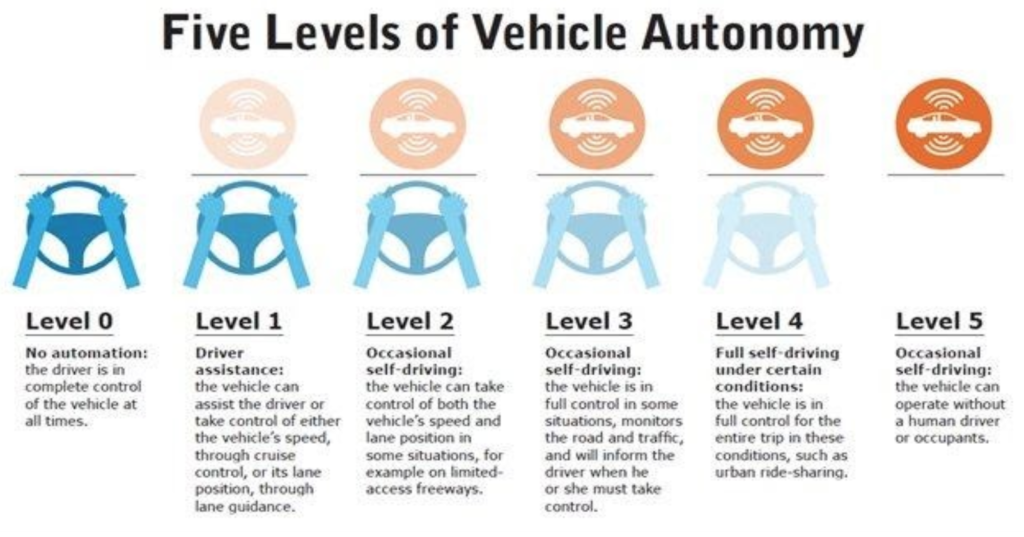
Source: Governors Highway Safety Assn.
Autonomous vehicles have logged millions of miles with lower incident rates than human operated ones. The technology is in a constant state of improvement. Systems, like Intel’s ‘Mobileye’ already exist in over 50 million vehicles globally. Companies like Nvidia, are harnessing advanced computer technologies of incredible power. Products like their ‘Jetson’ and ‘Drive AGX’ will have a transformative effect in manufacturing, construction, food production, material delivery, marine products and human mobility; it’s all about to change.
A whole new class of autonomy is arriving with products like ‘Open Pilot,’ a $1,000 retrofit that upgrades newer level 1 vehicles to level 2-3 autonomy. This is a breakthrough product category that is constantly evolving using AI, crowd sourcing and machine learning.
The integration of autonomy will be in phases. It has already begun in vehicles that have lane keeping, collision avoidance and adaptive cruise control. Human oversight will be needed for the first couple generations as technology refines and autonomous cars and Robo Taxi’s become ubiquitous:
- Sensor systems and awareness of the dynamic world around the autonomous vehicle is still evolving. Low cost, uniform standards need further development.
- V2X has had several successful tests and standards are in process, but widespread implementation of the technology is still to be done. This is an area of investment Austin should be focusing on.
- Consumer confidence levels and acceptance of the technology, by the public at large still needs improvement. People will be surprised by the pace of technology and the speed of transition.
It’s a good time for Austin to keep its powder dry. Cities burdened with obsolete, expensive-to-operate rail systems will envy our restraint. A lot of forward-thinking programs exist at the Federal level to foster the New Mobility. As technologies prove their merit, policy will shift accordingly, as it has with solar and electrification. Forward-looking projects will have better opportunity for Federal funds without standing in line for a diminishing pot of money. The Federal Capital Investment Grant (CIG) program for transit is overwhelmed and many cities have complete applications ahead of Austin. Better funding opportunity may exist off the beaten path.
FUTUREPATH
Source: techcrunch.com
Austin has an opportunity to set a new standard for express urban transportation. ProCON would dedicate billions to the “Orange Line” alignment, to serve a tiny fraction of our transportation demand.
Austin traffic congestion centers on north-south travel. The existing primary conduits, IH-35 and Mopac, need help. The US183/Bergstrom expressway and 360 improvement will improve flow, but more can be done. That could come in the form of a revolutionary, ‘FuturePath’: a dedicated express pathway, designed for the New Mobility and V2X; an efficient people and material moving machine. Imagine the expertise and funding this prototype would attract.
We could create a 4-6 lane dedicated pathway along this alignment, with mobility hub pull outs, to get loading/unloading and exiting vehicles out of traffic flow. Many of these hubs can also serve as pocket parks and community gathering areas. Associated tri-use micro mobility lanes could connect the hubs to the neighborhood. Over passes at east/west cross streets will eliminate intersection conflict.
Most importantly, ‘FuturePath’ will be exclusively for V2X and autonomous enabled vehicles. It would be particularly valuable for first responders and emergency vehicles, providing quick access to six Austin hospitals. These are vital functions in an urban environment, public transit cannot provide. As technology advances, we will have infrastructure to take advantage of it. FuturePath could serve as a technology test bed, attracting key players in the industry; Austin’s smart mobility program was established for new mobility ideas like this.
One lane on Mopac and IH-35 could similarly be dedicated to V2X and autonomous enabled vehicles (and HOV/express use). This will also foster demand for connected technology to begin cutting traffic congestion in a safe, controlled environment.
We shouldn’t waste time and money engineering ProCON. Those resources could be channeled into Austin’s ‘FuturePath,’ something that can deliver on ProCON promises to more people.
E-COMMERCE – AUTOMATION – DIGITAL WORKPLACE
Automation has been quietly and rapidly changing our world. It began in the 80’s with the advent of inexpensive micro-processing. Automated teller machines and word processors were in a first wave. Self-checkout, online banking, video education, record access via internet and other applications are commonplace. Proof of this progress can be seen in the growth of FANG stocks (Facebook, Amazon, Netflix, and Google) in the past decade. Big change will come with quantum/GPU/edge computing power, artificial intelligence, machine learning, 3d, robotics, sensor/IOT, and more.
E-COMMERCE
Historically, shoppers drove personal vehicles around from store to store. Today, much of that activity is done in the comfort of the home, with a computer. Less “shopping” trips, equal cars off the road and lower demand for retail space.
This diversion of consumer purchasing activity has put pressure on traditional brick and mortar storefronts. Where stores pull up stakes, the locations and parking lots can be re-purposed into a mix of housing, commercial and public/pedestrian spaces. This can occur without a lot of disruption and complication since development and infrastructure already exists there. It can be the beginning of a new “conversion industry.”
In-home purchasing migrated from mail order catalogs and 800 numbers, to the Internet where Amazon has emerged as the largest retailer. Grocery operations like HEB, Walmart, Whole Foods and others have also launched online stores with delivery service. At some point, the Internet of Things will increasingly automate routine consumable purchases.
An associated leap in efficiency also exists in the actual delivery of goods and material to the end user (logistics), helping diminish roadway demand, but more is needed. The supply chain, from manufacturer to end user, has become more direct. Goods go from automated distribution centers directly to the consumer, reducing trucking and transfers of goods through traditional retail sales outlets. Coordinated and consolidated delivery systems, soon to be automated with ‘internet of things’ (IoT), will make the process even more capable.
Growing demand for e-commerce delivery will result in 36% more delivery vehicles in inner cities by 2030. Autonomous airborne and ground-based delivery systems, will augment or replace many of the delivery vans we see today. UPS, the USPS, Federal Express and others are experiencing a revolution in their industry and business models. They are already planning a transition of services and have pilot projects for intelligent delivery in progress. This isn’t the future; it’s today!
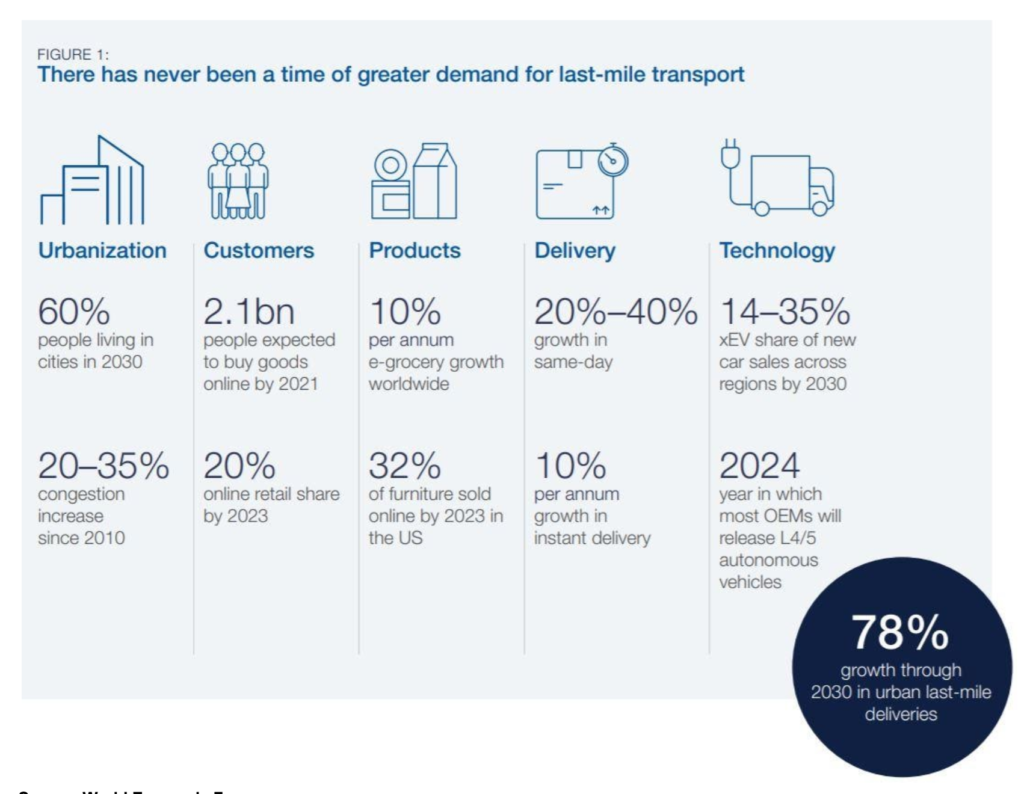
Source: World Economic Forum
FURTHER SUGGESTED READING: https://deloitte.com/us/en/insights/focus/future-of-mobility/future-of-freight-connected-data-intelligent-automation.html
AUTOMATION
The robots are coming; jobs and traffic congestion is leaving!
A coming wave of automation system integration, on the scale of the 18TH century industrial revolution, is transforming manufacturing and the workplace. A growing number of low skilled work positions, are being assumed by robotic systems. Already commonplace in large manufacturing facilities, automation is extending outward and downward. Food services, retail, construction, finance, transportation and other industries are all targets for this change.
Demand for “living” wage, leave benefits and imposition of government employment regulation, has helped drive the automation transition. Systems are now becoming more “off the shelf” with pre-packaged solutions that are cheaper to implement. As automation systems are deployed, an associated decline in workforce will occur; less workers mean less commuters, less commuters mean less traffic congestion.
It’s hard to predict what the world will bring in the next decade. The safest prediction is that things will change. Instead of burdening citizens with higher taxes for a questionable transit plan, we should be working to make Austin more affordable and prepare for the impact of automation on jobs. Our unprecedented low unemployment and growth won’t last forever.

DIGITAL WORKPLACE
A side effect of the pandemic is an accelerated migration from centralized offices, that impose high overhead, to distributed work-from-home. Corporations forced to limit their office workplace due to coronavirus, have been forced to make the leap to a digitally connected workforce. This has changed the paradigm of workscenters and the associated commuting activity. A ‘Next Generation’ workplace model is being adopted by, based on one survey, two thirds of corporations. This is a trend that is here to stay and will reduce traffic congestion and commute demand.
Movement to this distributed, remote digital workplace has the additional advantage of allowing greater access to talent pools that have traditionally been regionally constrained. Lower overhead, more access to talent/expertise are powerful motivators for business.
While the traditional office environment isn’t going away completely, the trend is toward remote work-from-home. The justification for fixed destination, high capacity transit is eroding in the face of this Digital Workplace revolution.
ELECTRIFICATION – ALTERNATIVE TRANSPORTATION ENERGY
ELECTRIFICATION
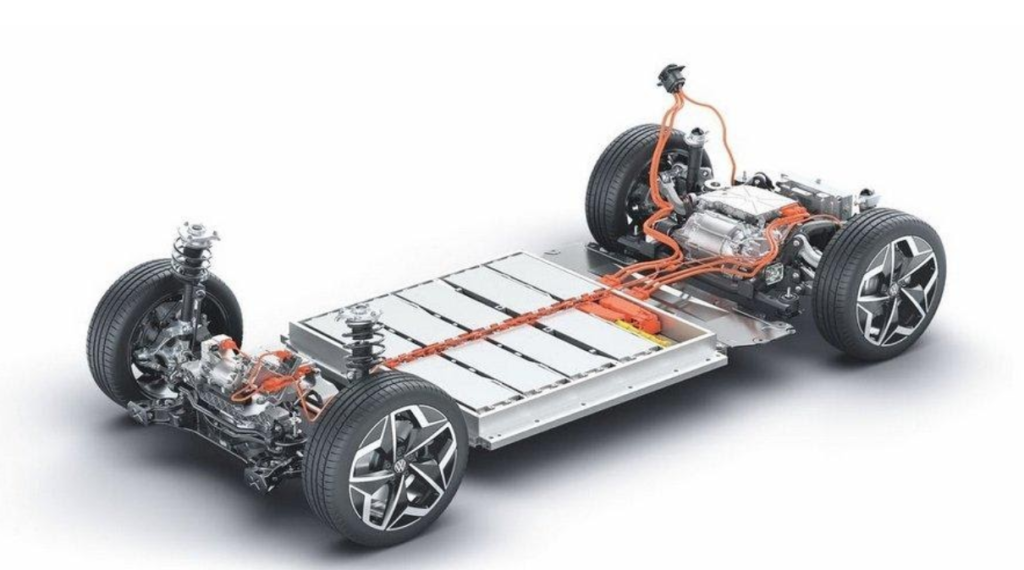
Source: Volkswagen
Driven by concerns for air quality and climate change, future vehicles powered by brushless electric motors, will become a standard.
They aren’t completely free of environmental cost, due to toxic chemicals used in their construction and the emissions from electric generation (unless their charge comes from nuclear or renewables). Electric vehicles (EVs) also place a high demand on certain materials like copper, with the associated environmental impact from mining and refining.
Electrified mobility is the future and we should embrace the technology to become less reliant on fossil fuel alternatives. Greatly simplified mechanicals, lower maintenance, enhanced durability, and carbon neutrality make electrified the logical choice for the New Mobility.
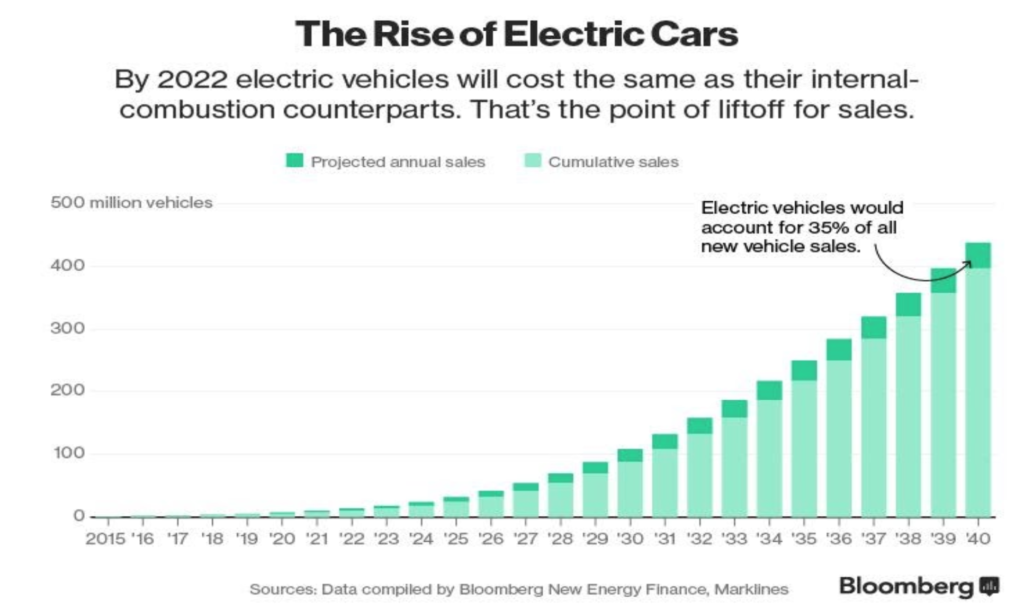
Electric vehicle fuel cost per mile, is a fraction of one powered by fossil fuels. As solar generation becomes more efficient, with power often directly captured by the consumer, operating cost will continue to decline. America has significant domestic fossil fuel reserves that assure legacy vehicles a stable fuel source, for their remaining useful life. A “collectable” market for older ICE powered vehicles will continue to exist. There is also likely to be a growing number of hybrid vehicles for applications that need greater range of operation between charges and load capacity.
The cost to maintain an electric vehicle is far less than one with an ICE. Fewer moving parts, mean less maintenance and adjustment. The driveline components are far more compact and lend themselves to a modular design, reducing manufacturing and repair costs. Regenerative braking, suspension, and steering systems are electronically controlled and contribute to reliability.
INHIBITORS OF ELECTRIFICATION
- Range anxiety: Electric vehicles now commonly break the 200 mile/charge baseline, with some exceeding 400 miles. There is a trade-off between battery capacity and range and evolving battery technologies are moving the goal post. https://rmi.org/wp-content/uploads/2019/10/rmi_breakthrough_batteries.pdf
- Charging Station infrastructure: Austin has been a leader in implementing accessible charging stations, but we are going to need more, a lot more.
- Roadway and on-board charging technologies: Many are in development to augment charging stations.
- Vehicle purchase price: Current offerings are expensive; prices will fall as sales rise. Vehicle cost will plummet when China enters our domestic market. They have positioned themselves as global leader in electric cars and buses.
- Comfort with the technology: As with anything new, mass adoption takes time. People need to develop comfort and confidence in the technology.
As the share of electrification in our mobility network rises, mobility costs will fall, along with public transit demand. Think smaller, simpler, cleaner, quicker, quieter, safer, cheaper – a lot of “er’s.”
Three things will hasten the demise of Fixed-Route/Fixed-Schedule public transit:
- Time-value: Inherent time-consuming inconvenience, particularly in our modern “on demand” world, where time is more valued.
- Better alternatives: Superior decentralized, on-demand/point-to-point options
- Lower-cost personal vehicles: Electrification and renewables will deliver.
Status quo public transit systems like ProCON are about to be caught in a perfect storm of cost, convenience, and better alternatives. When costs for more convenient alternatives fall, so does transit ridership. Think Uber and Lyft.
“Electricity is less expensive than gasoline and EVs are more efficient than gasoline vehicles. Electricity prices are also generally much more stable than gasoline prices. On a national average, it costs less than half as much to travel the same distance in an EV than a conventional vehicle.”
U.S. Dept. of Energy
HYDROGEN-POWERED VEHICLES
Another energy option is hydrogen power. Three automakers currently produce hydrogen vehicles: Toyota, Honda and Hyundai. The current weak links are fuel cost, availability and refining emissions. These are all areas in need of improvement. Vehicle and fuel production costs, make this a limited, fad technology for the near term.
HUMAN-POWERED VEHICLES
Human-powered bicycles, skateboards, tricycles, kick scooters and roller skates all facilitate mobility at little cost to the environment. Reduction of carbon output and health benefit from the exercise. A win-win for Austin, lets be sure they have safe space to operate.
RENEWABLE ENERGY
Many believe that to meaningfully address climate change and hold temperature rise in this century to 1.5°C, vehicle electrification and clean distributed solar source power, is requisite. Like the New Mobility, our vision of the energy future is also distributed. Carbon reductions from ProCON, would be insignificant and are a trendy sales pitch. We support conversion and investment into renewable energy. Around 60% of human-generated carbon emissions come from electricity generation and transportation – we can change that. That said, a fundamental question should be asked: WHAT EMPIRICAL EVIDENCE EXISTS TO DEMONSTRATE WE CAN REVERSE CLIMATE CHANGE?
Solar panel energy capture efficiency is advancing at an amazing rate. Based on the current evolution of solar panels, solar will dominate the energy market. Higher efficiencies allow more practical implementation of solar in less space. Enough energy from the sun hits the earth in one hour to power our entire planet for a year! High-efficiency photovoltaic collectors, integrated into electrified vehicles, will help recharge their batteries.
Currently, renewable energy technology is unable to consistently meet demand; for that reason, a storage component is required. There are many technologies and methods for reserve energy storage. Here’s a good primer video on the subject:
Massive investments in battery manufacturing and steady advances in technology have set in motion a seismic shift in how we will power our lives and organize energy systems as early as 2030. Battery/storage products like Tesla’s “Power Wall” are being developed by several well financed companies. Electric vehicle batteries may someday contribute to a distributed storage network, that provides distributed power when the sun’s not shining – a ‘Napster’ for power. Our cars and homes can become part of a transactive energy environment. Currently we use centralized generation electricity – coming from a power plant. A lot of future power demand will be fulfilled by a distributed generation network, where generation is closer to and often owned by the end user. To realize this future, there will be the need to overcome special energy interests that want to perpetuate the centralized model – like the City of Austin’s Austin Energy.
Improvement in solar panel technology is driving down cost. Technologies like dual side and 3D panels, transparent panels, thermophotovoltaics, perovskite crystal and flexible panels are shifting the industry. The existing efficiencies of 12-18% are soon to be eclipsed by new technology panels boasting 25% and higher. (Video on current solar panel technology: https://youtube.com/watch?v=8t_DFI4O6v4.) New material science, like capture technology and battery storage advances, promise cheap, efficient, and abundant solar power. Widespread integration of solar into everyday infrastructure will help meet future demand for electricity.
Austin has abundant sunlight and some of the lowest solar integration costs in the country. Just as distributed, on-demand mobility, will render fixed-route public transit obsolete, distributed transactive power generation & storage will make coal-fired power plants obsolete.
A BETTER USE FOR THE TUNNEL MONEYFor the (OLD) cost of the dubious ProCON tunnel, we could install solar panels on all of the residential structures in Austin.
This would provide a smaller carbon footprint, modernization of our power grid, and a leap to equitable, affordable, clean energy. This plan would create thousands of semi-skilled, ‘clean energy,’ economy-boosting, jobs. Distributed, solar power, sets us up for the coming clean, electrified New Mobility. The best part? Reduced or eliminated electric bills for Austin residents!
In contrast, ProCON, costing many times this solar plan, would only serve a small segment of our community. It also costs hundreds of millions annually to operate/maintain and despite proponents claims, would have little net impact on climate change.
We can be a leader in renewable energy, fighting climate change and affordability, or, we can spend a generational investment on an expensive, obsolete liability. The choice is clear.
|
ROADWAY IMPROVEMENT
IMPROVED ROADWAY MARKING & CONTROL
The day will come when we no longer need traditional traffic control devices. It’s difficult to precisely predict the timing and implementation of advances in technology, but roadway control 20 years from now will look and function very different from today.
We need to make sure our roadway line striping, pavement and signage is up-to-date. On-board driver assist and safety systems rely on camera sensors and look for lane lines. As pavement wears and fades, the marking contrast also diminishes. High-contrast striping, besides helping human drivers, allows camera-based recognition systems better discriminate the roadway, improving performance and safety.
Roadway agencies will continue to maintain roadways well into the future for a mix of human, machine and fully automated vehicles. In this shared environment, marking definition will likely increase in importance. Level two and higher automated vehicles benefit from enhanced road markings to safely navigate problem areas like work zones.
ROADWAY EXPANSION – RECONFIGURE FOR HIGHER THROUGHPUT
Systems like INRIX’s AI based transportation analysis, provide unprecedented ability to analyze activity on our roadways with high granularity. We now have the ability to accurately define and target the segments of our transportation system, where greatest need exists. The growing use of expert systems, employing AI, machine learning and advanced software, is central to improving mobility and will bring major change.
TxDot’s intersection work on 360 is long overdue, it will prove transformative for vehicle movement in that corridor. Already congested 620, must resolve existing conditions and accommodate future growth in the corridor. These are only a couple of the many places ProCON does nothing for.
Roadway capacity improvement, reduces the needs for new road building. Many existing roads have ample right-of-way to support additional traffic lanes. Extra lanes can serve as turning ques and help keep straight lanes open. Our city is littered with constrictive, frustrating roadway conditions that can be remedied at reasonable cost and with limited disruption. Good examples are South 1st at Annie & Mary where turning is inhibited and backs up traffic. Another is Guadalupe at the UT campus, where frustrating conditions exist, much of it a result of removing lanes for public transit and inhibiting turns.
The “Go Big” mobility bond passed four years ago promised bus pull-outs to get loading and unloading vehicles out of the traffic lane. How many have been implemented? How much traffic needs to be stifled behind buses on main arterials like Lamar and Burnet before the promise is kept?
HOV DUAL-USE LANES
Dallas and Houston use HOV lanes to great effect, why doesn’t Austin? If the goal is higher occupancy, reward it. V2X enabled vehicles and express transit should also capitalize on HOV benefit. Dedicate the inside free lane on Mopac and IH-35 to HOV during commute periods. 360 also has abundant right of way and is a prime candidate for a V2X/express/HOV corridor.
INTELLIGENT SIGNAL SYSTEMS
Modernizing our traffic signals is another promise made to sell the “big/bold” 2016 mobility bond. Since that bond was passed, we could have done scores of intersections and achieved long promised “synchronization.” We haven’t.
Smart camera-based traffic controls that integrate machine learning, artificial intelligence and fuzzy logic can efficiently reduce wait times at intersections. They save time, move traffic, and reduce emissions. The cost is surprisingly low because much of the technology is mature and “off-the-shelf,” and supporting infrastructure (like poles and equipment cabinets) typically already exist. Other cities have implemented these cost-effective improvements on a large scale; why hasn’t Austin? The Austin Transportation Department has made efforts in this direction; it’s a good start, but much, much more needs to be done.
There are efforts to apply artificial intelligence (AI) to make sense of large amounts of information and change the way that we move around our cities. INRIX rolled out their AI traffic analysis last year, its resolution lets us analyze our movement in great detail. This promises a revolution in the targeting and resolution of traffic congestion.
Researchers are exploring how traffic management systems can become more dynamic and responsive through the use of AI and information sources like Inrix. Surtrac technology is being used at 50 intersections in Pittsburgh and since launching, it has reduced wait times at intersections by up to 40%, according to the company. It also claims that journey times in the city have fallen by 25% while vehicle emissions have dropped by up to 20%.
The Austin Smart Mobility program plans 50 DSRC/V2X compatible intersections in the near future, 15 by this summer. They are also looking at putting signal equipment below ground, freeing up right-of-way, for physical intersection and roadway improvement.
Future traffic controls will be so complex that technologies like AI will be vital. Machine learning will allow us to constantly update the traffic patterns and thus traffic flow. This results in less idle time and fewer emissions.
RAMP METERING
More than 2,100 ramp metering installations exist in 29 metropolitan areas; none are in Austin. IH-35 and Mopac (i.e. Steck, Far West, 38th) are ideal for this improvement.
Examples of Ramp Metering benefits:
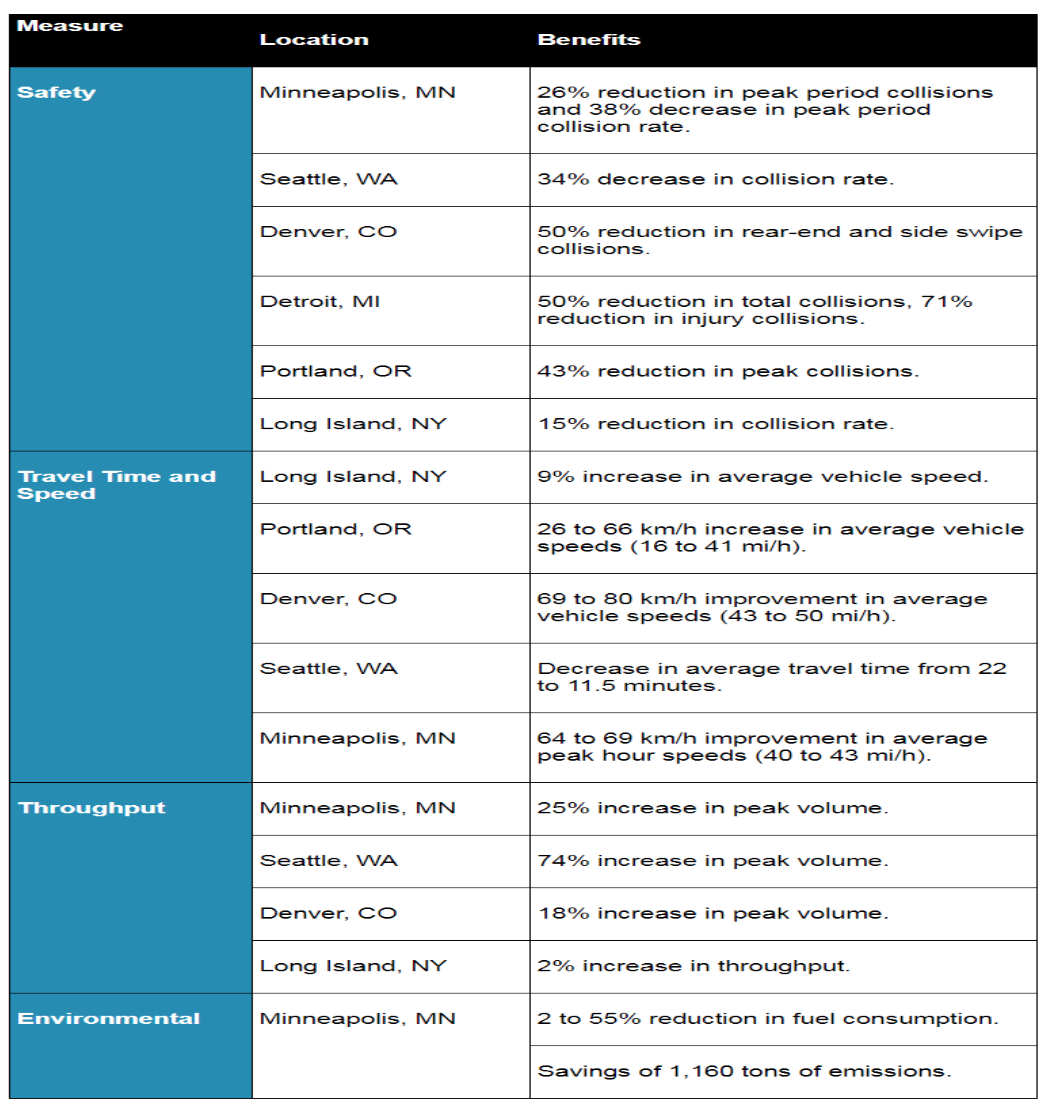
Source: Federal Highway Administration
INTERSECTION ENHANCEMENT FOR CAPACITY, EFFICIENCY AND THROUGHPUT
Re-configuring intersections can have tremendous benefit for traffic flow and safety. We should be using the latest INRIX AI data to target intersection upgrades based on traffic flows. Longer turn lane ques buffer turning traffic and get it out of thru lanes in busy intersections.
The improvement of Mopac and Slaughter, a simple re-configuration to diverging diamond, made this a model intersection. Displaced left turn, diverging diamond, median U turn, thru U turn, quadrant, and roundabouts offer a diverse toolkit to improve flow, reduce intersection dwell time, and traffic congestion.
Between Austin Transportation Department and TxDOT we have an abundance of talented roadway engineers. For a small portion of ProCON cost, we can empower them to reduce intersection congestion and delay. Wasting funds on ProCON will assure these needed improvements go unfunded and the unacceptable status quo remains.
ROADWAY IMPROVEMENT FOR THE NEW MOBILITY
Highway construction or expansion should include provision for the expanding Micro-Mobility whenever possible. A comprehensive network of Tri-Use pathways, should be as much as a priority as general roadway in our urban core. Our goal should be to implement a safe, inviting conduit for bicycles, pedestrians and micro-mobility. In the New Mobility, this infrastructure can move just as many people in urban environments as roadways.
Shared mobility and micro transit have their own roadway needs. Passenger access zones and mobility hubs will need right of way and facilities. Public-private-partnerships can help defer the cost for this infrastructure. It is crucial these facilities remove loading/unloading vehicles from the traffic flow; anyone stuck behind a bus, can attest to the value of that.
ROADWAY MANAGEMENT
Transportation experts and police understand, the leading cause of traffic congestion and accidents, is driver error. We can reduce this key problem with policy, at low or no cost, here’s some suggestions:
Increase penalties for distracted driving Distracted driving is a major cause of accidents – its reduction will improve safety and traffic congestion, at little to no cost. Existing state and local laws prohibit cell phone use while driving, yet these laws are violated with impunity. Escalating penalties and making sure the public is aware of the increase, could correct most of this bad behavior. $250 for first offense, $500 for a second and $1,000 thereafter should curb violation.
Increase penalties for aggressive driving Aggressive drivers speed, excessively change lanes and follow too closely on our highways. Often, their actions result in road rage, accidents and physical altercation. If we are to reign in the bad behavior, violators should be subject to similar fines, as those for distracted driving. Once people feel the financial sting of their bad behavior, they will reform.
Public education outreach to reduce driver error, aggressive and disrespectful driving People routinely turn across double yellow lines, solid white lines, double white lines and jump curbs. They follow too closely, change lanes too frequently, fail to drive proactively, use exit lanes as their private passing lane, fail to yield and rush to the front of traffic backups – exacerbating and perpetuating the backup. We should be producing and airing public service announcements to illustrate bad behavior and teach proper roadway etiquette.
Improve roadway accident and breakdown clearing with response teams Proper accident response, can mitigate the resulting congestion. Major roadways should have assigned tow and accident response teams to quickly remove vehicles and debris from the roadway. Houston’s “safe clear” created a coordinated response for inoperable vehicles on major roadways. CTRMA’s ‘Hero’ program is also a step in the right direction. Unfortunately its odious overuse of emergency lighting, generates traffic congestion. Their large arrows confuse people into thinking a lane is closed ahead, setting up mass lane change conflict.
Reduce and minimize use of emergency lighting for non-emergency conditions There’s excessive blue/red light use for non-emergency conditions on our roadways. It distracts drivers, slows traffic and foments congestion. Emergency lighting in the blue/red range should be exclusive to emergency vehicles and employed in emergency situations, with yellow for non-emergency application. Excessive use of emergency lighting for routine applications like work zones, desensitizes drivers and reduces their effectiveness.
Reduce traffic enforcement during rush hours Nothing is more frustrating than sitting in a line of stop and go traffic, expecting an accident or road closure ahead, then finding it’s just a traffic stop. This disruption degrades roadway flow, often causing far more problems than it resolves, including collisions. Rush hour traffic stops should be restricted to the most egregious of offenses.
TRANSPORTATION DEMAND MANAGEMENT
Traffic Demand Management (TDM), uses information, encouragement, penalties and incentives to reduce cars on the road, particularly during high demand periods. There are both traditional and innovative technology-based services to help inspire people to use transit, micro-mobility, ridesharing, walking and telework.” The COVID19 crisis illustrates the effect of TDM. It has reduced the demand on our roadways and shortened trip times, particularly in the commute periods. The ‘silver lining’ of that black cloud is that people and businesses are learning work-from-home is viable and even desirable. We expect to see significant roadway and public transit demand decreases as a result of COVID19.
PARKING MONETIZING / CONSTRICTION
It is believed that if you reduce parking availability, you will reduce the number of vehicles in a given area. Or if you impose enough impediments, people will accept inconvenient public transit. People, like water and electricity, will seek the path of least resistance. It’s unrealistic to expect people in to abandon the convenience, time saving, capacity and versatility of a personal vehicle. There will be some vehicle reduction from these tactics but very little. At the end of the day, it’s a money stream for the government, penalizes personal vehicles and there is little downside for them.
ROADWAY ACCESS MONETIZING / VMT TAXES
‘Roadway access’ can be like congestion pricing, but without the congestion. Toll roads and bridges are the best examples. Robert Moses built his bureaucratic/autocratic empire on a toll bridge – a man ahead of his time. Again like parking, it’s a money stream for the government, penalizes personal vehicles and there is little downside for them. One side effect does come up, the program is regressive and penalizes low income travelers. The rich can afford to pay the extra costs but those costs can present a burden to those of limited means.
CONGESTION PRICING
“Congestion pricing is a way of harnessing the power of the market to reduce the waste associated with traffic congestion. Congestion pricing works by shifting some rush hour highway travel to other transportation modes or to off-peak periods, taking advantage of the fact that the majority of rush hour drivers on a typical urban highway are not commuters. By removing a fraction (even as small as 5 percent) of the vehicles from a congested roadway, pricing enables the system to flow much more efficiently, allowing more cars to move through the same physical space. Similar variable charges have been successfully utilized in other industries – for example, airline tickets, cell phone rates, and electricity rates. There is a consensus among economists that congestion pricing represents the single most viable and sustainable approach to reducing traffic congestion.” Consensus isn’t empirical evidence and technologies like V2X will have far greater impact on congestion, without the penalties.
Source: https://ops.fhwa.dot.gov/congestionpricing/cp_what_is.htm
WORK-FROM-HOME & TELEWORK
Telecommuting/Telework, around for decades has taken off in recent years – largely due to technological advancement in the form of Personal Computers and reliable internet connectivity. Employees can now stay connected via video and data networks. Just as in transportation, the distributed model in the workplace, promises great change. Banking, customer services, on-line education and medicine are all areas that can benefit from telework efficiencies.
The recent COVID-19 crisis has accelerated the adoption and demand for work-from-home and tele-medicine. It provides a “test run” for virtual workplace expansion in government, medical and business. Expect this transition to become permanent as workers migrate to distributed workspaces, further reducing traffic congestion and reducing demand for public transit. To fully realize the distributed workplace model, we need to resolve security, computing power, and socialization issues. Another facet of telework is the worker doesn’t have to live near his job in many cases. This allows for a distributed, suburban population that doesn’t commute or need public transit, we are already seeing these migration patterns.
IMPACT OF TELECOMMUTING:

Source: EHSToday
Almost 40% of the American workforce already works remotely in some form. More Austin workers telework than use public transit! Lower cost electronics with better reliability, combined with high speed internet and home networks will continue to expand this segment going forward. Leaps in hand held computing power, provide function beyond the business computers of only a decade ago. Tablets and smartphones offer portable business solutions that can make anywhere a workplace for many jobs.
“With a quarter of all employed Americans working from home, telecommuting has moved beyond being just another Millennial trend. It’s become a way of life, disrupting the traditional workplace as we know it with employees who are happier and more productive.”
-Forbes magazine
Studies show those who work from home have less stress and are more productive than workers in traditional 9 to 5 jobs. Telecommuting/Telework not only saves time and money, it results in fewer cars on the road, reducing the emissions that contribute to pollution and global warming.
Tele-work benefits: http://teleworkva.org/whatIsTelework/benefits.aspx
SUGGESTED FURTHER READING: https://forbes.com/sites/andrealoubier/2017/07/20/benefits-of-telecommuting-for-the-future-of-work/#6c6bd81316c6
ALTERNATIVE WORK SCHEDULES & COMPRESSED SCHEDULES TO SHIFT OR REDUCE COMMUTES
Compressed Work Schedules allow employees to work longer hours and have one or two regular days off per pay period, reducing the number of days employees need to commute to work.
Flexible Work Schedules allow employees to vary their start and stop times each day, and can be used to avoid peak traffic hours.
Maxiflex is a type of Flexible Work Schedule that allows employees, within the limits established by their organization, to: vary their start and end time each workday, vary the total number of hours worked each workday, split their schedule up to 3x in one workday, and/or vary the total number of hours worked each week. These flexibilities can be used to alleviate commuting frustrations in a wide variety of ways
Source: https://traffic.nih.gov/Pages/workschedule.aspx
PARKING “CASH OUT” INCENTIVES
Cashing out employer-paid parking, can benefit commuters, employers, taxpayers, and the environment. An employer can provide employees a choice of a parking spot or cash stipend. Employees can then use the cash to leave the car at home, carpool, use rideshare/TNC, transit, micro mobility or if proximity allows, buy some good walking shoes. Bike lockers and showers can make bicycling more practical for many workers, particularly on hot summer days.
We may someday discover improved efficiency in mobility results in excess capacity on existing infrastructure and decreased travel time. That, ironically, would make policies discouraging and penalizing automobile use largely worthless.
CITY OF AUSTIN
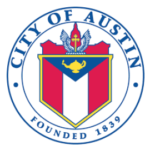
“SMART MOBILITY” PROGRAM
There are promising signs at Austin Transportation and their preparation for future mobility technologies. They hired an enthusiastic department head, with significant private sector experience to run smart mobility. This fast paced, rapidly changing area requires engaged, intelligent staff to keep Austin in the game and up on evolving technology. It is the “tip of the spear” for Austin’s mobility future and implementation of the New Mobility.
We’re encouraged by the Cities efforts in Smart Mobility. It is a part of government where Public-Private partnerships, can benefit our mobility. This group should be generously funded and given priority in determining mobility for our city. All roadway improvement should go through their review and validated through the lens of coming technology.
We’re concerned, ProCON if passed, would consume needed funding for the work of the Smart Mobility group. ProCON is the past, Smart Mobility is the future; let’s make it a priority.
“Smart mobility involves deploying new technology to move people and goods through our city in faster, safer, cleaner, more affordable and more equitable ways. Austin Transportation seeks to foster creative, mutually beneficial partnerships to carry out real-world testing of smart mobility technology, such as shared, autonomous, connected and electric vehicles.”
Source: http://austintexas.gov/department/smart-city
“COMMUTE CONNECTIONS” PROGRAM
The Commute Connections Program helps City of Austin employees understand their sustainable commute options and take action to reduce their drive-alone work trips, especially during peak travel times. The ultimate goal is to minimize the impact these commutes have on traffic congestion and air quality in our region
Source: http://austintexas.gov/commuteconnections
TRANSPORTATION DEMAND PROGRAM (TDM)
“Our department’s Transportation Demand Management Program works to encourage sustainable modes of travel and relieve traffic congestion in Austin and its regional neighbors. Transportation demand management promotes solutions that move trips to off-peak hours or shift drive-alone trips to other forms such as public transit, walking, biking, teleworking, carpooling, and vanpooling.”
Source: http://austintexas.gov/department/transportation-demand-management
URBAN TRAIL EXPANSION
Urban trails can offer an additional tier of transportation infrastructure for bicycles, micro-mobility and pedestrians. They typically have the wonderful side benefit: communing with nature. Fortunately, we have significant right-of-way in Austin for these trails.
Some urban trails are better suited for recreation and exercise than transportation. The trail from Govalle Park to Decker lake is a great example. It’s an asset to our community and offers cyclists an excellent facility for their pastime.
Use of urban trails for micro-mobility must be carefully controlled. Mixing motorized vehicles with pedestrian traffic can have safety issues. Regardless, a good plan and judicious implementation can make this a safe, efficient, transportation option. We should install compliant, safe, inviting, 10-12 ft+, tri-mode upgrades on all compatible urban trails.
TRI-MODE PEDESTRIAN/BICYCLE/MICRO-MOBILITY LANES
Micro-mobility infrastructure should protect vulnerable users from cars/trucks, avoid conflict and co-exist with other modes; particularly in the urban core. While everyone isn’t comfortable with, or able to ride a bicycle, a major segment of citizens can take advantage of this form of travel. It has the side benefits of physical fitness and low carbon output.
Micro-mobility vehicles, for the most part, present a similar pathway profile to the bicycle. If we properly lay out our bicycle lanes to share, it will enhance their value as a mobility asset. Tri-mode, cement, 12 ft+ width, is the gold standard. Like urban trails, implementing reasonable safety rules and regulation, can make dual-use lanes a safe, efficient, environmentally friendly option. The City should be investing in a robust micro-mobility compatable, tri-mode pathway network.
Source: https://austintexas.gov/department/shared-mobility-services
RECONSTRUCTION OF EXISTING SUB-STANDARD STREETS
Austin has a number of streets that have fallen into dis-repair in need re-configuration and re-paving. These efforts can provide opportunity to modify these transportation conduits to meet future demand. The City has leaned on TxDot to do much of the work for them, it’s time they step up to the plate, dedicate the funds and bring our neglected infrastructure up to par.
Expanding the roadway, adding bicycle/micro-mobility tri-mode pathways, re-configuring intersections and putting signal infrastructure below grade to better utilize right of way, can help bring sub-standard roadways into the 21st century. It will also benefit more citizens than ProCON and have a far greater impact on traffic congestion at far lower cost.
ELIMINATE CITY OF AUSTIN EXCLUSIVE PARKING – PUBLIC TRANSIT MANDATE
If shared mobility and less cars on the road is the city’s goal, it should lead by example. Reserved City employee parking should be eliminated, starting with the Mayor, City Council and City Manager on down. These spaces should be available to those that paid for them, at their maintenance cost. City employees should be required to use public transit or shared mobility unless they have a valid reason to commute in a single occupancy vehicle.
The mayor and city council should be required to use public transit or shared mobility for city business and commutes to/from their office. How can they expect others to use public transit if they won’t themselves? They should be intimately familiar with the associated inconvenience and time sacrifice. Without that perspective, how can they craft informed policies on the subject? If City leaders are sincere in their beliefs, they will set the standard for the behavior they want others to adopt by example. If they’re not embracing public transit, why should anyone else?
CAPITAL METRO

IS IT TIME TO FACE THE REALITY THAT RUNNING EMPTY BUSES ALL OVER OUR CITY MAKES NO SENSE? How long are we going to fund Capital Metro to “go through the motions”, pretending it’s providing a needed service? Look closely at any bus you see, does it have many riders? Operating these huge, expensive, traffic blocking buses with a couple of passengers is wasteful and the public is forced to pick up the tab.
CAPITAL METRO “METRO ACCESS”
We believe there is no more important mobility service a community should provide, than that which serves our disabled and handicapped. We support the paratransit efforts of Capital Metro, however we could be providing superior ON DEMAND, POINT to POINT service to these travelers without the overhead and bureaucracy of Capital Metro. ProCON would do little to serve this vulnerable group and in many cases, requires them to transfer vehicles, struggle to get to pickup points and fails to take them to their ultimate destination. We should be providing ride-share passes for this segment of our community along with a dedicated fleet of micro-transit vehicles specifically designed to serve these travellers.
CAPITAL METRO’S “METRO RIDESHARE”
The program provides eligible groups of 5 to 12 riders with a month-to-month vanpool lease agreement, including insurance, maintenance, 24-hour roadside assistance and an optional fuel purchasing program.
“The MetroRideShare program is sponsored by Capital Metro and operated by Enterprise, a national vanpool service provider. Together, we provide all the services necessary for you to enjoy a comfortable, convenient and economical commute to work.
To start or join a vanpool, register with Enterprise or call 512-477-7433 (RIDE) to get started.”
EXPRESS COMMUTER BUS – PARK & RIDE EXPANSION – METRO RAIL
A former bright spot in Capital Metro’s ridership, this is a function transit can do well and provides benefit to our community. However, COVID has devastated this service with less commuters and few of them willing to cram into a bus breathing re-circulated air.
The Metro Rail is losing money, lots of it, ridership has plummeted and the future looks dark. Funding for improvements were allocated in 2014, but ridership is so low, they are hard to justify. This train costs too much, does too little, and illustrates how Austinites, outside a few peak commute hours, have a little appetite for rail. It may be time for CapMetro to cut their losses on its “high capacity” Metro Rail. A new Downtown Station was constructed at a cost of $35 million. It’s essentially a couple cement slabs and five oddly shaped shade covers – for THIRTY FIVE MILLION! It’s an embarrassment and massive waste of funds – particularly when you consider the New York Metropolitan Transit Agency purchased GRAND CENTRAL STATION with over 50 train platforms and a huge historic building for THE SAME AMOUNT! https://progressiverailroading.com/passenger_rail/news/MTA-takes-ownership-of-Grand-Central-Terminal–59979
BUS ELECTRIFICATION
“The agency’s board of directors approved a contract that will put the first electric buses on Austin streets by the end of 2019, and started the transformation of a former Serta Mattress warehouse into a storage and smart charging facility for future electric vehicles.
The vehicles are manufactured by Proterra, Inc., one of the three manufacturers that provided electric buses to the agency in 2018 for a demonstration project. An all-electric fleet is a primary goal of ProCON and a crucial component of its plan for sustainable public transit. It’s realization is a long way off – if ever.
“The new bus yard will be able to accommodate 214 buses. The agency is in the demolition phase of construction process, removing the former Serta warehouse in north Austin. Construction is scheduled to start in the fall of this year (2019), and the bus yard could be ready for operations in summer 2020.” We are now in late 2021 and this yard is still a vacant lot – what does this say about Capital Metro’s ability to get things done?
CAPITAL METRO’S “PICKUP” PROGRAM
Capital Metro is offering On-Demand / Door-to-Door service to a three Austin areas and Manor where it replaces the 470-bus run. This application-based service mimics Uber or Lyft’s service available in most major cities. Capital Metro charges $1.25 per trip and under 18 rides free. They also offer 7- and 31-day passes. The service is available weekdays from 7 a.m. to 7 p.m. Based on statements made by Randy Clarke, Capital Metro’s CEO, the Manor run has resulted in a major ridership turnaround. “Pickup” is a heavily subsidized service that isn’t sustainable on a large scale. It does however, demonstrate the door-to-door/on-demand model is far superior to the current fixed-route/fixed-schedule methodology. Paratransit and Metro Access has given Capital Metro some good hands on experience. We see the potential of this service to migrate to micro transit, and become a primary function of Capital Metro.
“Book a ride using the Pickup app for $1.25 per trip – the same as a single ride for MetroBus and MetroRapid”
“Our on-demand service allows you to seamlessly share your trip with other riders also going your way. Book a ride and within seconds our powerful algorithm matches you with a vehicle that can pick you up. Pickup by CapMetro is a new model of on-demand transit – ride hailing that is also truly ride sharing, with a bus that comes to you when and where you need it.”
Source: https://capmetro.org/pickup-faq/
CENTRAL TEXAS TRANSIT FACE-OFF:
|
FAIR/FARE PLAN
If the sincere goal is to provide mobility for those who are transit-dependent and/or low income, Capital Metro should implement a “FAIR/FARE” plan. Issue fare discount cards based on Median Family Income (MFI) and set a higher rate for riders able to pay their fair share.
Anyone participating in the following programs should be eligible for a discount card:
- Medicaid
- Medicare
- Children’s Health Insurance Program (CHIP)
- Supplemental Nutrition Assistance Program (SNAP)
- Comprehensive Energy Assistance Program
- Housing Choice Vouchers
- Texas Temporary Assistance for Needy Families (TANF)
- Texas Special Supplemental Nutrition Program for Women, Infants and Children
Fair/Fare will improve fare recovery, cash flow and make Capital Metro more fiscally sustainable based on its service. It will at the same time, target services to those most in need in a cost-effective way. We must, in a modern society, help provide transportation for people who are disabled, elderly and/or low-income, who may be reliant on public transit.
Charging higher fares to those who can afford them is fundamental to making the agency more fiscally sustainable and gets riders to support the services they use. Taxpayers shouldn’t be subsidizing transit for those able to pay their fair share.
A CAPITAL METRO OF THE FUTURE
Capital Metro should be migrating to a distributed, micro-transit model, scaled to demand and spring-board off their “Pickup” application. They should concentrate on regional Park & Ride services for commuters that leverage HOV/V2X/Express lanes, establish Mobility Hubs, and expand into docked micro mobility solutions. Capital Metro can find new relevance delivering MaaS across several platforms.
ELIMINATE CAPITAL METRO ALTOGETHER
The current pandemic has exposed the vulnerability of public transit as a viable entity. Ridership plunges that are likely to become the new normal make a system that already had poor ridership even less feasible. Perhaps this is the time to consider moving to a better way forward.
Capital Metro’s 2020 spending, divided by projected ridership, shows a boarding cost of over $13 their fare recovery is $0.73. Since 1990, Capital Metro’s primary revenue source has increased over 500% with no ridership increase; Capital Metro is providing LESS for MORE!
We should end the practice of publicly subsidizing riders who don’t need it. That would leave a robust pool of funding to subsidize, on-demand/door-to-door mobility options for residents who are transit-dependent and/or low-income. A subsidized, outsourced, on-demand rideshare model would eliminate most of Capital Metro’s overhead and eliminate running all those buses with few riders. It would also allow conversion of several prime tracts occupied by Capital Metro for affordable housing. The result? Superior mobility services for those who need it most, lower tax overhead, and affordable housing.
Public transit systems, in their current state, are dinosaurs doomed to extinction. ProCON would double-down on that failing paradigm. The New Mobility is going to change things, let’s start thinking out of the box and begin investing in the future, not the past.
COST FOR THE EXISTING METRO RAIL:
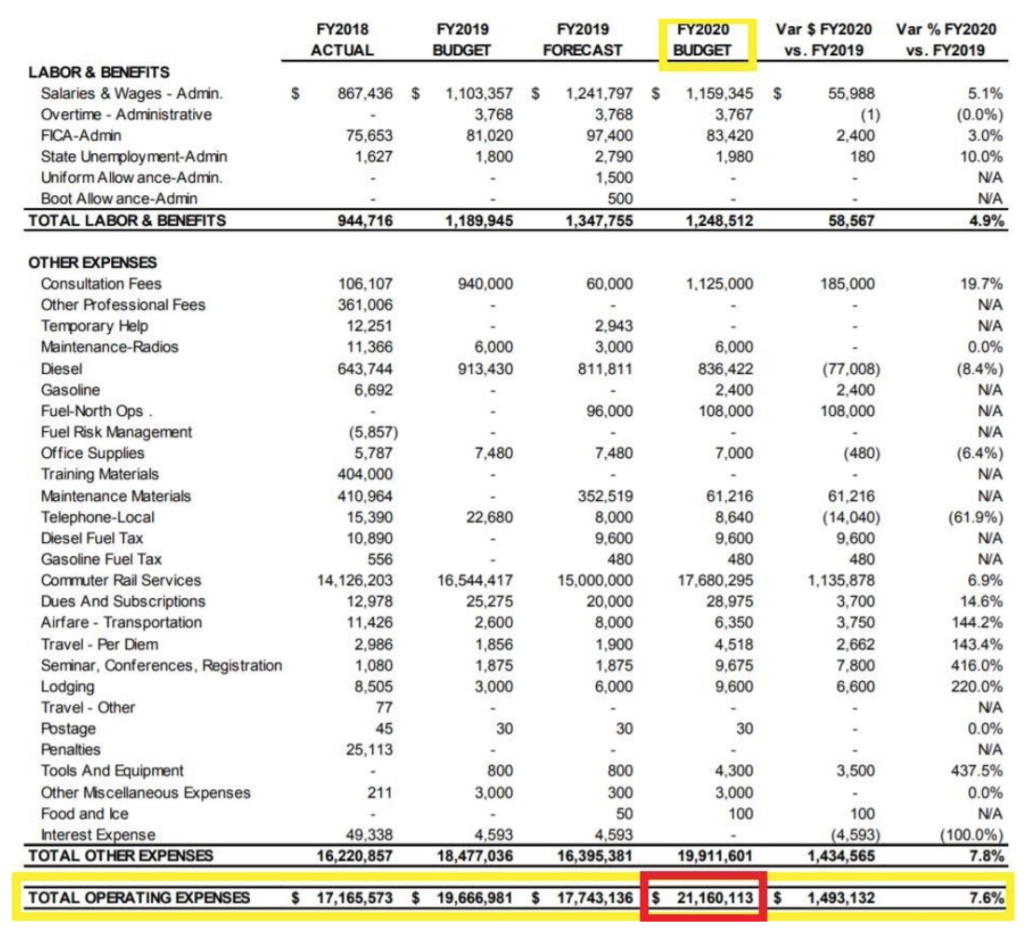
METRO RAIL CAPITAL EXPENSES I&S

NOTES
- 2020 cost per boarding = $37.25 (Total Expenses: $21,160,112 ÷ 568,020 Metrorail riders)
- 2020 cost per boarding including Capital Expenses = $69.57 ($21,160,113 + 18,356,106 = $39,514,219 ÷ 568,020 Metrorail riders)
ProCON BUDGET
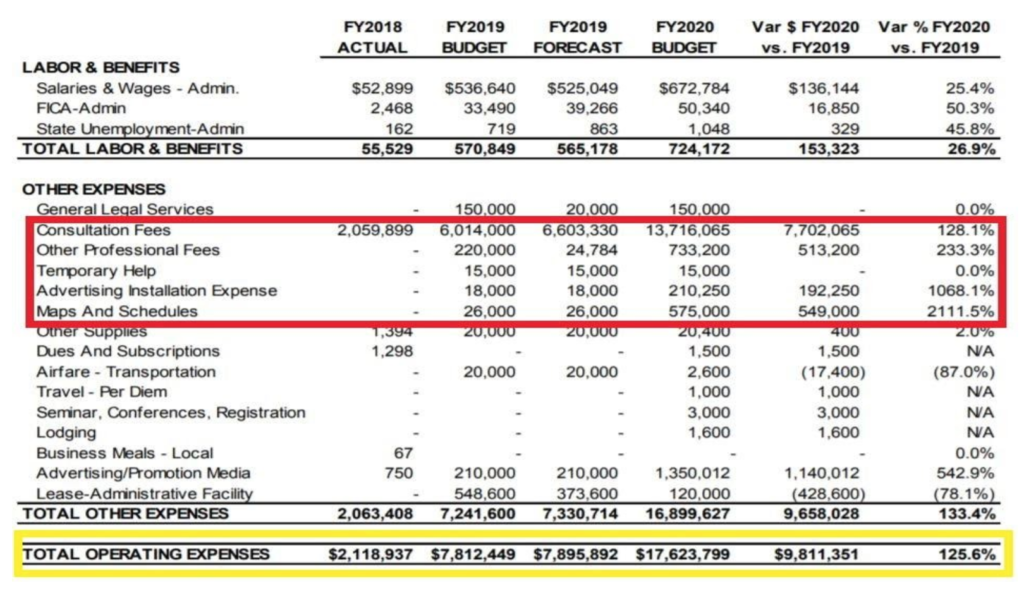
NOTES:
- Total operating expenses increased 126%, for a program unapproved by voters
- Consultant fees increased 565% from 2018
- Consultant fees increased 128% from 2019
- Professional fees increased 233% from 2019
- Advertising Installation increased 1068%
- Advertising and Promotion increase 543%
- Maps and Schedules increased 2112%, yet there is no system running or established
RED LINE PARKWAY INITIATIVE

“The Red Line Parkway Initiative (RLPI) is a 501(c)(3) nonprofit organization founded in 2017 that empowers diverse communities to enjoy, develop, and enhance the Red Line Trail and Parkway corridor to serve Central Texas mobility, recreation, parks, arts, affordability, social equity, physical & mental health, public space, and economic needs. The Red Line Parkway is a proposed linear park and public space along the planned Red Line Trail, extending 32 miles from Downtown Austin to Leander. Our vision is a thriving, inclusive, multi-functional parkway that provides convenient, enjoyable, car-free access to transit, parks, public art, and other urban, suburban, and rural destinations. Our vision for the Red Line Trail includes a paved surface, separate parallel trails for bicycling and pedestrian access where feasible, complete grade-separation from motorized street traffic (bridges and tunnels at streets), and gentle inclines of 1-3% grade.”
Source: https://redlineparkway.org/
The initiative seeks to create a pathway that could serve micro-mobility in our city. While not specifically designed for consistency with the tri-modal concept, this initiative has the right idea. This idea could assume the entire right of way used by Metro Rail allowing an initial spine for micro-mobility. Because Metro Rail is such a failure and consumes so much money, it could make sense to eliminate it altogether and use the valuable right of way for superior micro-mobility use that will serve far more mobility in our community.
MOVABILITY CENTRAL TX

This is a public transit-centric entity that somewhat duplicates the efforts of the Cities TDM (Transportation Demand Management) department. They operate as a non-profit and appear to be as more a cheerleader for ProCON as a transit entity. They are currently involved in a program where the city is giving them hundreds of thousands of dollars in city taxes to fund free rides on Capital Metro.
“Movability is Central Texas’ first and only transportation management association. We are solely dedicated to working hand in hand with employers to improve the regions’ economic vitality by connecting commuters with mobility options that save time and money.”
Source: https://movabilitytx.org/
CAPITOL AREA COUNCILS OF GOVERNMENT

“Commute Solutions is a ‘one-stop’ transportation resource in Central Texas promoting sustainable options that reduce traffic and improve mobility.
Commute Solutions encourages alternative travel options like carpools, vanpools, transit, bicycling, teleworking and walking. They work to help you learn about your regional mobility choices no matter where you live or what your needs are.
By reducing the amount of single-occupant vehicle trips, sustainable transportation can save you money and protect our environment. Sustainable commuting reduces traffic congestion, benefits economic development, and improves quality of life for all.
Commute Solutions resources serve the citizens and businesses of Bastrop, Blanco, Burnet, Caldwell, Fayette, Hays, Lee, Llano, Travis, and Williamson counties.”
Source: https://mycommutesolutions.com/
SMART TRIPS AUSTIN
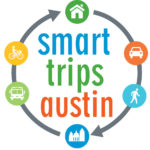
“The Smart Trips Austin program is designed to help Austinites find transportation solutions that work for your everyday trips. Whether it’s riding the bus, carpooling, biking, walking, or trying one of our city’s ever-expanding mobility options, we’re here to help you get around—and avoid traffic in the process. Smart Trips Austin hosts free events like transit adventures, walking tours, and bike rides; offers transportation information and resources; and provides one-on-one personalized support.
The program, which is a partnership between the City of Austin and Capital Metro, focuses on different neighborhoods within Austin each year. To find out where we’ll be next, stay tuned here and on Facebook.”
Source: https://smarttripsaustin.org/
MARKET-DRIVEN SOLUTIONS
Demand and innovation will define many of our future mobility options. Price will dictate their quality and success. A new industry is emerging. Transportation is central to our lives, society and civilization. Just as personal computer, internet and smart phone technologies changed our world; technology in transportation will lead to an age of New Mobility. This, for the most part, will take place in the free market funded by private entities, not government debt.
“We can no longer afford to develop, implement and invest in policies and infrastructure that rely on yesterday’s transportation and mobility solutions.“
– Tina Quigley GM, RTCSN
HYPERLOOP
With speeds up to 700 mph, hyperloop is an intriguing mobility concept with great promise, particularly for regional transportation. While still in the conceptual stages, operational prototypes are functioning and being refined. Much work remains to be done and it will take massive investment and engineering to bring hyperloop to market. Regulatory and finance issues are still to be worked out. At this time, it’s more of a play toy for futurist billionaires like Elon Musk and Richard Branson – do they know something we don’t?
FUNDING ProCON
ProCON is sold with the “done deal” promise 40-45% will be paid by the Federal government. This promise is being made by political leadership in cities across our nation at a time of crisis and economic turbulence.
OVERALL FEDERAL FINANCIAL CONDITION
Our expanding national debt currently exceeds $28 trillion dollars; when George W. Bush left office, it was $10.6 trillion. Our national debt now exceeds GDP, it doesn’t take an economist to see we are on an unsustainable path. This debt is projected to rise indefinitely because we spend more than we take in, as opposed to having a balanced budget and have to spend more to service the debt (interest). Where the money will come from is unknown; few ask, and those in power have no answer other than to spend and spend more. We seem to exist in an alternate reality where the debt/deficit don’t exist and the party can continue on forever. Be forewarned: A soft landing isn’t in the cards.
Our nation saw one of the worst recessions in history a little over ten years ago. Today our economy is in trouble and depending on massive spending of borrowed money.
“Today, the United States faces the most serious fiscal threat in its modern history. Yet, this issue does not rank among the top five for American voters in the 2020 election campaign.”
– Public Policy Center, CED Conference Board
2020 TRUSTEE REPORT – SOCIAL SECURITY/MEDICARE: https://ssa.gov/oact/tr/2020/
SOCIAL SECURITY:
“Social Security’s total cost is projected to be higher than its total income in 2021 and all later years…. OASI and DI Trust Fund asset reserves become depleted and unable to pay scheduled benefits in full on a timely basis in 2035”
2020 TRUSTEE REPORT – MEDICARE: https://cms.gov/files/document/2020-medicare-trustees-report.pdf
MEDICARE:
“The Trustees project that the HI Trust Fund will be depleted in 2026. Medicare costs will grow from approximately 3.7 percent of GDP in 2018 to 5.9 percent of GDP by 2038”
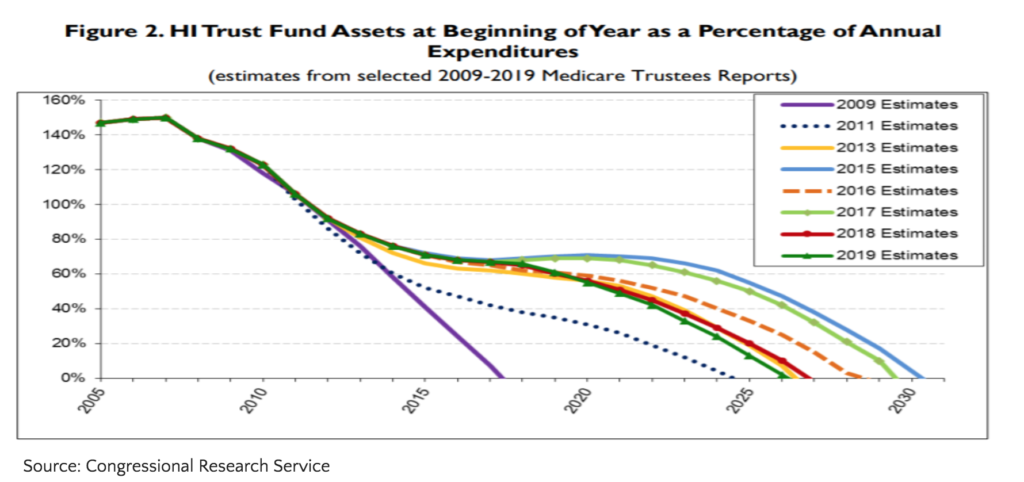
MEDICAID:
Medicaid is a struggling program with funding shared by Federal and State governments. Investors Business Daily, sums it up:
“Medicaid’s costs are swamping state budgets, climbing from 9% in 1989 to 20% today. The National Commission on Financing 21st Century Higher Education says that Medicaid’s explosive growth is crowding out funds that states used to spend on higher education… It’s the biggest budget-busting health care monster of all.”
– Investors Business Daily
FEDERAL FUNDING FOR PUBLIC TRANSIT
From ‘Transportation for America’; a transportation policy group:
- More than 40 percent of America’s buses and 25 percent of our rail transit assets are in ‘marginal’ or ‘poor’ condition.
- USDOT identified a backlog of $90 billion in capital investments needed to bring bus and rail systems just into a state of good repair.
Recent reporting shows New York City’s crumbling transit system is $45 billion in debt for repairs. $17 billion was approved in December to cover operating expenses, which are still projected to run a $1 billion/year deficit. MTA says another $40 billion is needed over the next decade for key infrastructure repairs. NYC transit system annual debt service has risen to 16% of spending at $2.6 billion – and rising. NYC transit ridership has decreased every year since 2015. The NYC MTA accounts for two-thirds of national rail transit.
Chicago has a $19.5 billion backlog just to achieve a minimal state of “good repair.” Costs are accelerating to maintain their aging system and people in their market are frustrated by massive incurable public debt and taxation. CTA is $30 billion short for needs of today and their 10-year capital need program, is $37.7 billion behind, as they scramble to find $3 billion a year. Like New York, San Francisco, and L.A., costs are rising as ridership falls.
We should be learning from these deteriorating “premier” transit systems.
FTA CAPITAL INVESTMENT GRANT (CIG) PROGRAM
The discretionary Capital Investment Grant (CIG) program provides funding for fixed guideway investments such as new and expanded rapid rail, commuter rail, light rail, streetcars, bus rapid transit, and ferries, as well as corridor-based bus rapid transit investments that emulate the features of rail. All projects must be evaluated and rated by FTA in accordance with statutorily defined criteria at various points in the development process.
This discretionary program requires projects to proceed through a multi-step, multi-year process, to be eligible for funding, with FTA evaluation and rating required at various points in the process. The first step is called Project Development and the second is a construction grant agreement.
Cities all over the nation, encouraged by rail lobbyists and consultants, are making the same federal funding promises as Austin. Given the plunge in ridership, federal debt/deficit, and COVID crisis, these discretionary programs are tenuous.
The AntiDeficiency Act, as Codified in Title 31, United States Code:
§1341. Limitations on expending and obligating amounts
(a)(1) An officer or employee of the United States Government or of the District of Columbia government may not-
(A) make or authorize an expenditure or obligation exceeding an amount available in an appropriation or fund for the expenditure or obligation;
(B) involve either government in a contract or obligation for the payment of money before an appropriation is made unless authorized by law…
§1350. Criminal penalty
This is why the underlying CIG statute (49 U.S.C. §5309) states that while a full funding grant agreement “may include a commitment, contingent on amounts to be specified in law in advance for commitments under this paragraph, to obligate an additional amount from future available budget authority specified in law,” that “The agreement shall state that the contingent commitment is not an obligation of the Government.”
“If Congress decides to stop funding FFGAs halfway through construction, the local transit agency has no legal recourse. The grant agreements clearly spell that out in legalese. Nevertheless, the transit agency would be in a world of financial pain were such a thing to happen.”
– ENO Center for Transportation
BALLOT LANGUAGE MUST REFERENCE FEDERAL FUNDING
Because of the tenuous nature of the Federal funding, taxpayers should be protected. Ballot language must make approval of ProCON contingent on securing the promised Federal funding. In normal business practice, there would be some guarantee of the funds, like a bond or letter of credit. Austin citizens could find themselves with an unfunded mandate that could raise the cost to local taxpayers 40%.
GOING DEEP INTO DEBT AND SPENDING BILLIONS IN THE MIDST OF A GLOBAL CRISIS IS INSANITY!
- A proven COVID-19 cure does not exist. It may be a long time before an effective vaccine is available, it may only have limited efficacy. COVID appears to be here to stay. Life as a result will be risky and require sacrifice and safeguards.
- We are not just going to snap back to pre-March 2020; that’s a fantasy. The world has undergone change that will be lasting. It’s not just a case of jumping in our cars and going back to business as usual.
- We have taken our economy off line for an extended period, an unprecedented action that will disrupt real estate, production of goods and the service industry.
- Our economy is in recession, potentially a new “greatest” recession, with unprecedented depth and breadth. It’s likely the effects will last for many years to come.
- Unemployment has reached 14.7%, far higher than the 10% of the “great” recession, the peak is still unknown. Many jobs will come back, many won’t.
- The “shelter in place” and “social distancing” edicts, will have lasting effect on the food/beverage, entertainment, wedding, convention (as we plan to expand our center), air travel, hotel/motel, sporting, large event industries and particularly public transit.
- Unemployment, decreased commerce and COVID related response have distressed tax revenues at all levels of government.
- Attempts to stabilize our economy has added trillions in debt to the government balance sheet.
- The Federal Reserve and our government’s expansion of the money supply, is diluting the dollar in a low interest rate environment. It’s probable this will result in INFLATION like most of us have never seen. As basic costs rise, tax increases will force working families to make some hard choices.
- A pension crisis looms. Most pension funds do not meet the reserve balances needed to backstop promised benefits. Decreased tax revenue will stress that imbalance. If equity markets fall, the reserve funds will also evaporate. Many local governments keep two sets of books, with the pension fund deficits off budget.
- State and local governments have coming challenges that will demand higher tax revenues to address. It’s not the time to be borrowing billions and counting on a tapped out federal government to send money.
FUNDING ProCON WITH PROPERTY TAXES
ProCON costs more than ALL the bond debt held by our city.
Project Connect
Annual Tax/Rent Increase Estimator
Increase based on traditional bond funding that taxpayers are most familiar with and M&O property tax levy. $9.798b principal, 20 year term, 2.33% APR, M&O $226m and current TCAD net-taxable real property value.
City Tax Only
People want to know one thing: What will ProCON cost ME?
The public believes ProCON’s $0.0875/$100 tax rate increase will fund ProCON – THIS IS COMPLETELY FALSE! That tax rate will hardly cover the maintenance and operating costs.
LIKE THE 2016 MOBILITY BOND, VOTERS ARE BEING MISLEAD WITH A FALSE NUMBER THAT IS INSUFFICIENT AND WILL REQUIRE MORE DEBT AND TAXES IN THE FUTURE.
8/2022 UPDATE: We now have actual tax receipt data for two years to PROVE we were right – the “historic, record” ProCON tax rate increase only covers a fraction of the cost. VOTERS WERE DECEIVED AND MISLED!
Paid for by Our Mobility Our Future PAC


